
More than 200,000 readers throughout Greater Washington


More than 200,000 readers throughout Greater Washington
By Margaret Foster
Imagine living your whole life at summer camp. That’s what the Markoff brothers — Nick, Alex and Matt — have been doing for 32 years.
The co-founders of Calleva, based in Maryland, Virginia and West Virginia, are “living the dream,” said Matt Markoff, executive director of the beloved area institution that buses kids to day camp to learn to kayak, go whitewater rafting, rock climbing, mountain biking and paddleboarding.
Since the Markoffs founded Calleva, the camp program has expanded to include an equestrian center, sustainable farm, river school, store and outdoor restaurant.
How it began
The brothers, now in their 50s, were accustomed to spending summers outdoors at their family’s day camp in Colesville, Maryland.
“We grew up at camp under the guidance of our parents and grandparents, who founded Valley Mill Camp back in the 1970s,” said Matt Markoff.
“We knew from early on that we wanted to think out of the box and try our own approach to summer camp.”
Their mission: to get people outdoors for safe, educational, challenging experiences that promote personal growth, teamwork and leadership skills.
With a dream of building a camp of their own, the brothers knew they had to raise some seed money. On a late-summer drive from Utah to Maryland in an old bus, they had an idea for a fundraiser: transform the bus into a haunted house on wheels and charge admission.
Four years later, they moved to the 168acre Calleva Farm, where Markoff’s Haunted Forest became a popular annual
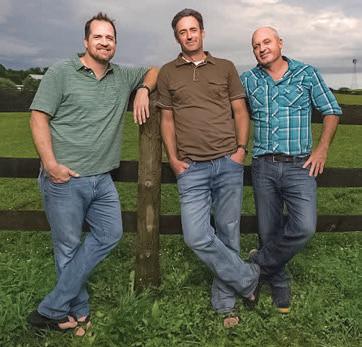
Matt, Nick and Alex Markoff founded Calleva camp three decades ago.
Calleva Farm.
activity, scaring kids and adults every September through November.
Nowadays the site, which has been featured on the Discovery Channel and Travel Channel, is so popular that 2,000 brave souls walk its spooky mile-long trail every night (including the Obama family several years ago).
“We spend all year building people’s confidence in the outdoors and one month tearing them back down,” joked Nick







Markoff, who oversees the “the haunt,” as he calls it.
With fundraising money in hand, the brothers were able to purchase canoes, paddles, lifejackets and climbing gear and open a small summer camp.
Their mother suggested the name “Calleva,” which means “place in the woods” in Celtic. With that, the Markoff family

LEISURE & TRAVEL
Visiting Spain for the olive harvest and Roman ruins; plus, a weekend on the Eastern Shore, and what to do when your flight gets cancelled page 34

ARTS & STYLE
Celebrating a beloved Maryland diner, where everybody knows your name; plus, Bob Levey on the upsides of simpler, older cars page 39









t s w strat t awcd d o niF l /moc . r.ter uo f yt i uo
s l a e h p .dae










Gaithersburg, Md. – The Carnegie at Washingtonian Center officially opened on August 15, 2024, offering seniors a new standard of living in Gaithersburg, MD. Located adjacent to the vibrant Washingtonian Center, The Carnegie offers a lifestyle destination where seniors can thrive.
The Carnegie is a full-service retirement community featuring 302 elegant one and two-bedroom residences across seven stories and 8.5 acres. It offers independent living, assisted living, and memory support, all within a thoughtfully designed environment that blends comfort and convenience.
The community celebrated its opening with a ribbon-cutting ceremony featuring The Carnegie’s General Manager, Jennifer Pastora, along with the community’s first residents, and Gaithersburg Mayor Jud Ashman.
“We are excited to welcome residents to The Carnegie and to begin this journey together,” said Pastora. “Our community is designed to not only meet but exceed the expectations of modern senior living. Our goal is to create a community where culture and connection thrive. We cannot wait to see all our residents make this their home!”

The Carnegie features Kisco Senior Living’s awardwinning The Art of Living Well programming, promoting whole-person wellness. It also upholds Forbes Travel Guide’s five-star service standards, ensuring exceptional care and attention for every resident.

Mayor Ashman shared his excitement for the opening, stating, “I couldn’t be more thrilled to see The Carnegie at Washingtonian Center open its doors. This moment represents hard work and innovation from The Carnegie team, and the city’s commitment to economic development and creating welcoming communities. More importantly, it represents new opportunities for retirees to make the City of Gaithersburg their home with enriched living, culture, and community.”
Aligning with The Art of Living Well program, The Carnegie has developed a strong sense of community through meaningful partnerships with local businesses and cultural institutions. Collaborations with The Art Collective, the Gaithersburg Book Festival, Fig & Fire, Sarah’s Handmade Ice Cream, The Wine Concierge, and more fill The Carnegie with culture and a lively community spirit, making it a truly enriching place to live.
The Carnegie residents enjoy access to premium amenities, including multiple dining venues, a wellness spa, a fitness center, an indoor heated saltwater pool, a lecture hall, an art gallery, and a cooking demonstration kitchen. The beautifully landscaped outdoor park and trails provide a serene escape, while the community’s prime location offers easy access to shopping, dining, and cultural events. The Carnegie is now open and hosts many signature events every month to provide a sample of what life at The Carnegie is all about. Schedule your personal tour in advance: 240-213-7383 or visit lifeatthecarnegie.com.
One aspect of Social Security that doesn’t get as much attention as retirement benefits is what’s known as Social Security Disability Insurance (SSDI).
Its monthly payments are designed to help workers who develop a life-threatening physical or mental disability, or one that will prevent them from engaging “in any substantial gainful activity” for at least 12 months.
The bad news is that perhaps one of the reasons it’s in better financial shape is that the SSDI determinations process is dysfunctional, with a waitlist of more than one million applicants (for a program that has seven million recipients). AARP reported that 30,000 applicants died while awaiting an SSDI determination last year.


Eligibility is based on age, degree of disability and length of work record, so the older the applicant, the better the chance of success. More than threequarters of all SSDI recipients are over 50, and 41% are between 60 and full retirement age. (Disability benefits end once regular Social Security begins.)
By Stuart P. Rosenthal
Funded by a portion of the payroll taxes withheld from workers’ earnings, SSDI is on a sounder financial footing than Social Security, with funds expected to last through at least 2098.
It takes the Social Security Administration (SSA) more than seven months to render an initial decision to applicants, up from about four months a few years ago.
If rejected initially, as about 70% of all applications are, there are then typically two levels of appeals.
An appeal for “reconsideration” requires another seven-month wait. If that’s denied, a person will typically wait another 15 months before the case is heard by an administrative law judge.
The biggest reasons for these delays may stem from problems not of the SSA’s making.
First, the number of Social Security beneficiaries overall is up about 25% since 2010 (yes, those aging baby boomers). At the same time, Congress has reduced the agency’s budget by nearly 20% in real terms, according to the Center on Budget and Policy Priorities.
We mentioned in an article last month that the average caller to Social Security is now waiting 36 minutes on hold. But that’s nothing compared to waiting 29 months for a determination on your disability claim!
However, it’s not clear that having an inadequate number of workers at SSA is the only problem. In some cases, it may have something to do with the staff they do have.
Disability applicants do not qualify for benefits if, despite their disability, they could still reasonably be expected to perform other “substantial” work in a different job.
To determine that, the SSA uses an outdated government listing of occupations developed by the Department of Labor in 1938 and last updated in 1991. Apparently, no other agency, including DoT, still uses the list.
As a result, the SSA sometimes denies disability benefits to workers when they could theoretically find work in occupations that are, in fact, not available in the present-day workforce.
insurance because he could obtain work in the U.S. as a “nut sorter, dowel inspector or egg processor,” based on the list.
In June, to some fanfare, SSA announced it had identified 114 occupations it would no longer use to deny eligibility. The three supposed occupations its expert cited are, unfortunately, not among them, though SSA did add that “nut sorter” is a career for which the agency will be “implementing additional evidence requirements” before using it to disqualify an applicant(!).
Economist Mark Warshawsky of the American Enterprise Institute reports that the SSA has spent more than $300 million over the past 15 years to commission a more realistic list of occupations from the Bureau of Labor Statistics. While that effort was at least partly complete by 2020, the agency has still not begun to use it, and SSA Commissioner Martin O’Malley told Congress recently that he wasn’t planning to do so.
So, while part of the blame should be placed on Congress for inadequate SSA funding, it sounds like the agency itself should take a good chunk of responsibility for its ongoing dysfunction.
A word to the wise: If you need to apply for SSDI, hire an attorney (on a contingency basis) who specializes in it. They tend to get better and quicker results.

TheBeacon is a monthly newspaper dedicated to inform, serve, and entertain the citizens of the Greater Washington DC area, and is privately owned. Other editions serve Greater Baltimore and Howard County, Md. Readership exceeds 400,000.
Subscriptions are available via first-class mail ($36) or third-class mail ($12), prepaid with order. D.C. and Maryland residents: add 6 percent for sales tax. Send subscription order to the office listed below.
Publication of advertising contained herein does not necessarily constitute endorsement. Signed columns represent the opinions of the writers, and not necessarily the opinion of the publisher.
Publisher/Editor –Stuart P. Rosenthal
President/Associate Publisher –Judith K. Rosenthal
Executive Vice President – Gordon Hasenei
Managing Editor – Margaret Foster
Art Director – Kyle Gregory
Vice President of Operations – Roger King
Advertising Representatives –Dan Kelly, M.K. Phillips, Alan Spiegel
Assistant Editor –Ana Preger Hart



The Beacon, P.O. Box 2227, Silver Spring, MD 20915 (301) 949-9766 • Email: info@thebeaconnewspapers.com Website: www.theBeaconNewspapers.com
Submissions: The
The Washington Post reported a couple of years back that a “vocational expert” hired by the SSA told an incredulous judge that the plaintiff should not qualify for disability

Readers are encouraged to share their opinions on any matter addressed in the Beacon as well as on political and social issues of the day. Mail your Letter to the Editor to The Beacon, P.O. Box 2227, Silver Spring, MD 20915, or email to info@thebeaconnewspapers.com. Please include your name, address and telephone number for verification.
Dear Editor:
Thanks to PEPCO.com/peak for advertising in the August 2024 Beacon to encourage their customers to save money by taking it easy on the air conditioning during peak hours. This also helps reduce pollution.
Dominion Power has similar programs at domsavings.com, helping you to do your own energy audit from home. Customers on both sides of the Potomac River should consider going solar on their homes, houses of worship (solar is heaven sent!), schools, commercial and industrial facilities. This will help reduce global warming, which, given this year’s record-breaking temperatures, should inspire us to take action on climate change. When our children and grandkids ask us what we did to save the planet for them, will we have excuses — or a good answer?
Charlie Garlow Citizens’ Climate Lobby Alexandria, VA
Dear Editor:
The issue of uncontrolled illegal immi-
gration has become so serious in our country that it has potential to decisively influence presidential elections.
Building a wall on our southern border may temporarily reduce illegal immigration but won’t solve the underlying issue. The root cause is the gap between the demand for, and supply of, low-level labor.
A Guest Worker Program offers a unique pragmatic solution that addresses illegal immigration without substantial costs, while boosting our economy.
Young individuals recruited to work in the USA will undergo technical training in trades such as plumbing, carpentry, gardening, nursing, caregiving and other needed sectors.
They would be issued work visas for a fixed duration, such as five years, and return to their home countries at the end of the contract period.
These workers would provide a trained workforce, fill low-paying jobs, and can help make American products more competitive.


















































































The FDA says e-cigarettes can reduce the harm of tobacco smoking for adults
PASS
Share your expertise with others in a volunteer job. How to find the right one for you ‘TIS THE SEASON
Eating fruits and vegetables that are in season adds variety and is healthier too PUMP UP THE VOLUME
Better hearing can stave off dementia. What to look for in OTC hearing aids
By Albert Stumm
Like many of us, Jessica Peoples has heard the warnings about excessive screen time at night. Still, she estimates spending 30 to 60 minutes on her phone before going to sleep, mostly scrolling through social media.
“Recently, I’ve been trying to limit the amount,” said Peoples, a discrimination investigator with the state of New Jersey. “I do notice that how much time I spend affects how long it takes to fall asleep.”
Over half of Americans spend time on their phones within an hour of going to sleep, according to a survey by the National Sleep Foundation. That’s the very latest we should shut off devices, experts say.
The brain needs to wind down long before bedtime to get the restorative deep sleep that helps the body function, said Melissa Milanak, an associate professor at Medical University of South Carolina specializing in sleep health.
“You wouldn’t take a casserole out of the oven and stick it right in the fridge. It needs to cool down,” Milanak said. “Our brains need to do that too.”
Why screens are bad at night
Upending your bedtime routine may not be easy, but insufficient sleep has long been linked to anxiety, obesity and other
negative outcomes.
Research shows smartphones are particularly disruptive to the circadian clock that regulates sleep and other hormones.
“There are a million and one ways screens create problems with sleep,” said Lisa Strauss, a licensed psychologist specializing in cognitive behavioral treatment of sleep disorders.
The brain, she said, processes electric light — not just a smartphone’s muchmaligned blue light — as sunshine. That suppresses melatonin production, delaying deep sleep. Even very little brightlight exposure in bed has an impact.
Of course, it’s not just the light that keeps you up. Doomscrolling through the news, checking emails, or being tempted by ever more tailored videos on social media has its own consequences. So-called “technostress” amps you up — possibly even triggering the brain’s flight-or-flight response.
And algorithms designed to be engaging compel many social media users to scroll longer than they intended.
“Now it’s 30 minutes later, when you wanted to watch a couple videos and fall asleep,” Milanak said. “People go down these rabbit holes of videos, and more and more people are getting hooked.”
Though much of the scientific research on
online media focuses on adolescents and young adults, Strauss said most of her clients struggling with insomnia are middle-aged.
The issue is not just curtailing phone use in bed, but phone use at night. That means redesigning your routine, particularly if you use your phone as a way to decompress.
It helps to create replacement behaviors that are rewarding. An obvious contender is reading a physical book (e-readers are better than phones but still cast artificial light).
Milanak also suggests using that hour before bed to take a warm bath, listen to a podcast, make lunches for the next day, spend time with family, or call a relative in another time zone.
“Make a list of things you like that never get done. [Before bed is] a great time to do stuff that doesn’t involve screens,” she said. Using a notepad to write down the todo list for the next day helps keep you from ruminating in bed.
Do those activities in another room to train yourself to associate the bed with falling asleep. If there’s no other private refuge at home, “establish a distinct microenvironment for wakefulness and sleep,” Strauss said. That could mean sitting on the other side of the bed to read, or
even just turning the other way around with your feet at the headboard.
Finally, sequester the phone in another room, or at least across the room. “Environmental control can work better than willpower, especially when we’re tired,” she said.
What if stopping doesn’t feel realistic? There are ways to reduce the harm.
Setting the phone on night mode at a scheduled time every day is better than nothing, as is reducing screen brightness every night. Or hold the phone far from your face and at an oblique angle to minimize the strength of the light.
Minimize tempting notifications by putting the phone on “do not disturb,” which can be adjusted to allow calls and messages from certain people — say, an ailing parent or a kid off at university — to go through.
But none of these measures gives you carte blanche to look at whatever you want at night, Strauss said.
She also recommended asking yourself why checking social media has become your late-night reward.
“Think about the larger structure of the day,” she said. Everyone deserves solitary moments to relax, but “maybe be more selfindulgent earlier” so you can sleep at night.
By Charlie Schmidt
Many doctors caring for older men like to track the results of a blood test for prostate-specific antigen (PSA), changes in which can indicate increased risk for prostate cancer.
When a PSA blood test produces an abnormal result, the next step is usually a prostate biopsy. A biopsy can confirm or rule out a cancer diagnosis, but it also has certain drawbacks.
Prostate biopsies are invasive procedures with potential side effects, and they often detect low-grade, slow-growing tumors that may not need immediate treatment — or any treatment at all.
Researchers are exploring various strategies for avoiding unnecessary biopsies. Specialized magnetic resonance imaging (MRI) scans, for instance, can be use-
ful for predicting if a man’s tumor is likely to spread. A blood test called the Prostate Health Index (PHI) measures various forms of PSA and can help doctors determine if a biopsy is needed.
In April, researchers at the University of Michigan published results with a test that screens for prostate cancer in urine samples. Called the MyProstateScore 2.0 (MPS2) test, it looks for 18 different genes associated with high-grade tumors.
“If you’re negative on this test, it’s almost certain that you don’t have aggressive prostate cancer,” said Dr. Arul Chinnaiyan, a professor of pathology and urology at the university, in a press release.
How the test was developed
To create the test, Chinnaiyan and his colleagues first turned to publicly available
databases containing more than 58,000 prostate cancer-associated genes.
From that initial pool, they narrowed down to 54 genes that are uniquely overexpressed in cancers classified as Grade Group 2 (GG2) or higher. The Grade Group system ranks prostate cancers from GG1 (the least dangerous) to GG5 (the most dangerous).
The team tested those 54 genes against archived urine samples from 761 men with elevated PSA who were scheduled for biopsy. This effort yielded 18 genes that consistently correlated with high-grade cancer in the biopsy specimens. These genes now make up MPS2.
Then the team validated the test by performing MPS2 testing on over 800 archived urine samples collected by a national prostate cancer research consortium.
Other researchers affiliated with that consortium assessed the new urine test’s results against patient records.
Study findings showed that MPS2 correctly identified 95% of the GG2 prostate cancers and 99% of cancers that were GG3 or higher. Test accuracy was further improved by incorporating estimates of the prostate’s size (or volume, as it’s also called).
According to the team’s calculations, use of the MPS2 would have reduced unnecessary biopsies by 37%. If volume was included in the measure, then 41% of biopsies would have been avoided. By comparison, just 26% of biopsies would have been
From page 6
avoided with the PHI.
Chinnaiyan and his co-authors emphasize that ruling out high-grade cancer with a urine test offers some advantages over MRI.
The specialized multi-parametric MRI scans needed to assess high-grade cancer in men with elevated PSA aren’t always available in community settings, for instance.
Moreover, the interpretation of those results can vary from one radiologist to another.
Importantly, the MPS2 can be updated over time as new prostate-cancer genes are identified.
Promising results
The new study results were described as promising by Dr. Boris Gershman, a urologist at Harvard-affiliated Beth Israel Deaconess Medical Center in Boston and a member of the advisory and editorial board for the Harvard Medical School Guide to Prostate Diseases.
“It does appear that the performance of the 18-gene urine test is better than PSA alone,” he said. But Gershman adds that it will be important to consider how such a
test will fit into the current two-stage approach for PSA screening, which entails prostate MRI when the PSA is abnormal.
Where MRI delivers a yes/no result (meaning lesions that look suspicious for cancer are either present or not), the MPS2 provides numerical risk estimates ranging between 0% and 100%. “The challenge with clinical implementation of a continuous risk score is where to draw the line for biopsy,” Gershman said.
“This research is very encouraging, since many men in rural areas may not have access to prostate MRI machines or the added sophistication that is needed in interpreting these MRI scans,” said Dr. Marc Garnick, the Gorman Brothers Professor of Medicine at Harvard Medical School and Beth Israel Deaconess Medical Center.
“A widely available urine test may eventually help provide more precision in determining who should undergo a prostate biopsy, and may also help to assess the probability that a cancer is clinically significant and in need of treatment.”
Charlie Schmidt is editor of the Harvard Medical School Annual Report on Prostate Diseases.
© 2024 Harvard University. Distributed by Tribune Content Agency, LLC.
Please patronize our advertisers. They keep the Beacon free!
For free materials about area housing communities, just complete and clip this coupon and mail, or take a picture and email it to the Beacon
District of Columbia
❏ Chevy Chase House (See ad on page 15)
Maryland
❏ Brooke Grove (See ad on page 10)
❏ Carnegie at Washingtonian (See ad on page 3)
❏ Cascades at Frederick (See ad on page 16)
❏ Charles E. Smith Life Communities (See ad on page 12)
❏ ChurchillSeniorLiving (See ad on page 8)
❏ Grandview,The (See ad on page 9)
❏ Homecrest House (See ad on page 18)
❏ Leggett, The (See ad on page 20)
❏ Park View Bladensburg (See ad on page 36)
❏ Park View Columbia (See ad on page 36)
❏ Park View Emerson (See ad on page 36)
❏ Park View Laurel (See ad on page 36)
❏ Residences at Spring Brook (See ad on page 19)
❏ Riderwood (See ad on page 9)
❏ Ring House (See ad on page 12)
❏ Willow Manor at Cabin Branch (See ad on page 23)
Virginia
❏ Ashby Ponds (See ad on page 9)
❏ Chesterbrook (See ad on page 8)
❏ Culpepper Garden (See ad on page 16)

❏ Falcons Landing (See ad on page 17)
❏ Greenspring (See ad on page 9)
❏ Harmony at Chantilly (See ads on pages 1, 14)
❏ Harmony at Spring Hill (See ads on pages 1, 14)
❏ Residences at North Hill (See ad on page 7)
❏ Sommerset (See ad on page 21)
❏ WoodleighChase/Erickson (See ad on page 9)
Check the boxes you’re interested in and return this form to: The Beacon, P.O. Box 2227, Silver Spring, MD 20915 or take a picture and email to housing@thebeaconnewspapers.com.


By Matthew Perrone
In June, the Food and Drug Administration authorized the first menthol-flavored electronic cigarettes for adult smokers, acknowledging that vaping flavors can reduce the harms of traditional tobacco smoking.
The FDA said it authorized four menthol e-cigarettes from Njoy, the vaping brand recently acquired by tobacco giant Altria, which also sells Marlboro cigarettes.
The decision lends new credibility to vaping companies’ longstanding claim that their products can help blunt the toll of smoking, which is blamed for 480,000 U.S. deaths annually due to cancer, lung disease and heart disease.
E-cigarettes have been sold in the U.S. since 2007, but in recent years their potential benefits for smokers have been overshadowed due to their use by adolescents and teens.
Altria’s data showed Njoy e-cigarettes
helped smokers reduce their exposure to the harmful chemicals in traditional cigarettes, the FDA said.
The agency stressed the products are neither safe nor “FDA approved,” and that people who don’t smoke shouldn’t use them.
Parents and anti-tobacco groups immediately criticized the FDA’s decision, which follows years of advocacy efforts to keep vaping flavors that appeal to teens off the market.
“This decision could mean we’ll never be able to close the Pandora’s box of the youth vaping epidemic,” said Meredith Berkman, co-founder of Parents Against Vaping E-cigarettes.
“FDA has once again failed American families by allowing a predatory industry to source its next generation of lifetime customers — America’s children.”
Youth vaping has declined from all-time highs in recent years, with about 10% of high schoolers reporting e-cigarette use last year.
Most teens who vape use disposable ecigarettes, including brands like Elf Bar, which come in flavors such as watermelon and blueberry ice.

Currently, the U.S. market includes thousands of fruit- and candy-flavored vapes that are technically illegal but are widely available in convenience stores, gas stations and vape shops.
All the e-cigarettes previously authorized by the FDA have been tobacco flavored, which isn’t widely used by young people who vape.
Long under regulatory review
Njoy is one of only three companies that previously received FDA’s OK for vaping products. The company’s products accounted for less than 3% of U.S. e-cigarette sales in the past year, according to retail data from Nielsen.
Two other companies — Vuse, owned by Reynolds American, and Juul — control about 60% of the market, while hundreds of disposable brands account for the rest.
The FDA action is part of a sweeping yearslong review of major vaping brands, including Juul and Vuse. It was intended to bring scientific scrutiny to the multibilliondollar vaping market after years of regulatory delays.
Those brands have been sold in the U.S. for years, awaiting FDA action on their scientific applications. To stay on the market, companies must show that their e-cigarettes provide an overall health benefit for smokers, without significantly appealing to kids.
“Based upon our rigorous scientific review, in this instance, the strength of evidence of benefits to adult smokers from completely switching to a less harmful product was sufficient to outweigh the risks to youth,” said Matthew Farrelly of FDA’s Center for Tobacco Products. AP





















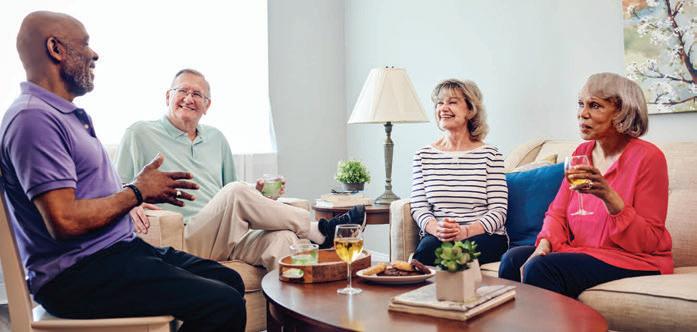



As experts in senior care, Brooke Grove Retirement Village is pleased to offer seminars and classes that promote physical, spiritual and mental well-being.


All programs will be held in-person in the Gathering Room at Brooke Grove Rehabilitation and Nursing Center, located at 18131 Slade School Road on the Sandy Spring, Maryland, campus of Brooke Grove Retirement Village. Register as indicated below or contact Toni Davis at tdavis@bgf.org with questions.
PARKINSON’S SUPPORT GROUP
Offered in partnership with the Parkinson Foundation of the National Capital Area
THIRD MONDAY OF EACH MONTH
10:45-11:45 A.M.
This group provides an opportunity for individuals and families to find support, gain understanding and share tips.
FREE with $50 annual PFNCA administrative fee. To register, visit: bit.ly/BGRVParkSupport
PARKINSON’S COMMUNICATION CLUB
Offered in partnership with the Parkinson Foundation of the National Capital Area
WEDNESDAYS
10:45-11:45 A.M.
This weekly wellness and prevention program for individuals with Parkinson’s disease and their care partners focuses on the maintenance of communication skills, with an emphasis on strengthening breath support and the ability to project and speak loudly enough to be heard in social settings.
FREE with $50 annual PFNCA administrative fee. To register, visit: bit.ly/BGRVParkCommClub
PARKINSON’S EXERCISE GROUP

Offered in partnership with the Parkinson Foundation of the National Capital Area
MONDAYS & WEDNESDAYS 12 NOON–1 P.M.
This ongoing class for those with Parkinson’s or other neurogenerative disorders aims to improve posture, balance and circulation while also increasing strength, muscle control and mobility.
FREE with $50 annual PFNCA administrative fee. To register, visit: bit.ly/BGRVParkExercise
WHY, HOW AND WHERE
Presented by Terrie Daniels, senior fitness and wellness specialist
TUESDAY, SEPTEMBER 24 10:30-11:45 A.M.
Flexibility training is important for everyday functioning, including pain relief and injury prevention. It can improve your golf swing, tennis game or other leisure activities you enjoy! Learn about when you should stretch and discover moves that can be carried out anytime, anywhere — whether seated or standing.
To register, visit: bit.ly/BGStretch
OFFICE OF CONSUMER PROTECTION INFORMATIONAL TOWN HALL
Offered in partnership with Montgomery County OCP
WEDNESDAY, OCTOBER 10 1-2 P.M.
Join District 7 County Councilmember Dawn Luedtke to learn more about OCP services and how this office can support you or a loved one with protection against scams, resolving credit and financial issues, and investigating and settling consumer complaints. Participants will also learn of recent changes in advance directives and how this option can help residents plan for future health care needs. This session is sure to empower as you gain deeper understanding of the OCP and its longstanding work of ensuring a fair marketplace for consumers and businesses.
FREE To register, visit: bit.ly/BGSCAM
By Dave Patel, M.D.
Dear Mayo Clinic: As I have gotten older, I notice that my eyes are almost constantly dry. I use over-the-counter eye drops to keep them moist, but I also have some itching and redness. What causes dry eyes? Are there any other treatments available to alleviate the condition?
A: Dry eye disease is a common condition that can cause an array of uncomfortable side effects, including blurry vision, eye redness, sensitivity to light, and a burning, gritty or scratchy feeling in your eyes.
Dry eyes happen because the eyes do not produce enough tears, or if the tears are not of adequate quality to keep the eyes properly lubricated.
To keep your vision clear and your eyes comfortable, you need a smooth layer of tears consistently covering the surface of your eyes. The tear film has three basic components: oil, water and mucus. Problems with any of these can cause dry eyes.
Many people may experience episodes of dry eyes during their lifetime. Aging, environment, hormones, air travel, the outdoors — there are a lot of factors that affect the lubrication of the surface of the eye.
Medications, eyelid problems and excessive eye strain may also result in dry eyes. Certain medical conditions increase risk for dry eyes, including rheumatoid arthritis, lupus, scleroderma, sarcoidosis, thyroid disorders and others.
For some people with chronic dry eyes, the problem stems from glands in the eyelids called the meibomian glands. Normally, these glands make oil that
slows the evaporation of tears. If the glands become blocked, tears do not contain enough oil. Then the tears evaporate too quickly, and eyes become dry.
The first line of treatment for dry eyes is to try over-the-counter lubricating eye drops. Many brands contain preservatives which help minimize the risk of contamination and infection. However, over time, the preservative can become toxic to the surface of the eye.
For chronic dry eye sufferers — those people who are using lubricating eye drops more than four times a day — preservative-free eye drops are best.
Use caution not to touch the surface of the eye when using drops, which could lead to contamination and infection. Consider single-use vials since they can be discarded after use, minimizing the risk of contamination.
If you have symptoms of dry eyes that do not respond to eye drops or other standard therapies, speak to an eye specialist, as there are prescription treatments available that could help if the problem is blocked tear ducts, including anti-inflammatory medications, neurostimulators that can trigger or increase tear production, and steroids to reduce inflammatory conditions.
If you experience dry eyes, pay attention to situations that are most likely to increase your symptoms. For instance:
• Avoid air blowing in your eyes. Don’t direct hair dryers, car heaters, air conditioners or fans toward your eyes.
• Add moisture to the air. In colder months, a humidifier can add moisture



to dry, indoor air.
• Consider wearing wraparound sunglasses or other protective eyewear. Safety shields can be added to the tops and sides of eyeglasses to block wind and dry air.
• Take eye breaks during long tasks. If you’re reading or doing other tasks that require visual concentration, take periodic eye breaks. Close your eyes for a few minutes. Or repeatedly blink for a few seconds to help spread your tears evenly over your eyes.
• Be aware of your environment. The air at high altitudes, in desert areas and in airplanes can be arid. When spending time in such an environment, it may be helpful to frequently close your eyes for a few minutes at a time to minimize the
evaporation of your tears.
• Position your computer screen below eye level. If your computer screen is above eye level, you’ll open your eyes wider to view the screen, speeding the evaporation of your tears.
• Stop smoking and avoid smoke. Smoke can worsen dry eye symptoms. Speak to your healthcare professional about how often you need eye exams.
Mayo Clinic Q & A is an educational resource and doesn’t replace regular medical care. For more information, visit mayoclinic.org.
© 2024 Mayo Foundation for Medical Education and Research. All rights reserved. Distributed by Tribune Content Agency, LLC.






r r..Rose Buchbin eople experienc -hearing journe de in helping r communicatio o help you!”




By Richard Siegfried, M.D.
Dear Mayo Clinic: For the last 20 years, I’ve worked a physically demanding job. As a result, chronic back pain has been an issue.
I’m ready to retire and want to enjoy activities, such as traveling, golf and playing with my grandkids, pain-free. What options are available to help alleviate and manage my pain? I’ve been told I’m not a candidate for back surgery.
A: The field of pain medicine has traditionally been a specialty associated with palliative treatments. Therapies were designed to treat a symptom or pain rather than correct an underlying condition causing the symptom.
Over the last decade, a shift in focus has transitioned to include minimally invasive treatments to improve or correct an underlying painful condition. Among these new treatments, one of the most exciting involves restorative neuromodulation.
In the past, neuromodulation in pain
Ikon Health offers:
• Care coordination with specialists.
• Access to services such as x-ray and blood work, at home.
• Close communication with patients and their loved ones.

medicine has been defined by implanted electrical devices. These devices “scramble” pain signals traveling through the spinal cord to the brain.
The devices addressed various painful conditions, including persistent low back pain in people for whom spine surgery is unlikely to be successful or beneficial.
The purpose has been not to correct the underlying condition but to reduce the painful symptoms. This works very well in many cases, but in some patients, the response is neither substantial nor long-lasting.
loss of control of the multifidus muscles, the largest stabilizing muscles of the spine. The failure of control in those essential stabilizing muscles can result in instability and misalignment. This can compound ongoing pain and risk for further injury.
Treating pain caused by muscle instability or misalignment is important and can be identified during physical examination. Loss of muscle control can be confirmed using MRI. Once these muscles have lost control, they atrophy and become replaced by fat. Fat within the muscle is easy to identify by MRI.


• Accepting Medicare, Medicaid and most major supplemental insurance plans.
Providing primary care medical services in the comfort and convenience of your home for patients who have difficulty traveling to an office. Call us today at 301.664.4209 www.IkonHealthMD.com










So, what is restorative neuromodulation? Restorative neuromodulation distinguishes itself from other forms of neuromodulation by correcting an underlying problem that results in pain reduction.
With a condition such as knee arthritis, the body can respond to a painful joint by inhibiting or “shutting down” the surrounding muscles. This process, known as arthrogenic inhibition, ultimately worsens the problem by creating instability in the joint.
A similar process can take place in the spine. An injury or stress to the tissues in and around the spine — including soft tissues, muscles, bones and joints — can result in persistent low back pain.
As a result of this pain, there can be a

Unfortunately, until now, an effective way to regain control of these stabilizing muscles, restore lumbar stability and reduce low back pain has been challenging to achieve.
Previously, the only treatments for this type of “mechanical” low back pain have been preventing normal biological function through surgically fusing the spine, ablating spinal nerves, or blocking painful sensations with opioids and spinal cord stimulation
Now, we can use an implanted restorative neurostimulation device, which causes repeated contraction of the multifidus muscles to reestablish their strength and restore sta-

Navigating Love in the

Digital Age: A Guide to Online Dating for Older Adults









C OMP L I M Y E V E N T S E N TA R F O RP O S I T E A G I N G IV






Charles E. Smith Life Communities, is all about. Join us atanyofour upcoming freeevents toexperiencethe magicofour dazzlingcommunityforadults 62+.

Thursday,September 12 11:30 a.m. | Virtual








Thisworkshopwill boost your confidence in creating an online dating profile, navigating dating platforms and developing strategies for a secure dating experience. Thriving Alone: Navigating Life as a Solo Ager
Tuesday,September 17 11:30 a.m. | Ring House A panel of expertswill discussstrategies and resources to help yousuccessfully navigate life as a solo ager. To RSVP, call 301-381-2702 or visit CESLCBeacon.org





By Howard LeWine, M.D.
Q: I was recently diagnosed with mild heart failure. But my echocardiogram showed a normal ejection fraction. Why would I still have heart failure?
A: Heart failure conjures up the image of your heart suddenly stopping. But it actually means the heart is not pumping as it should.
Impairments in pumping action can develop in the entire heart or just the left or right side. Most heart failure is caused by left-sided problems: the left ventricle (the heart’s largest chamber) is either too weak or too stiff to pump normally.
To figure out what is happening, doctors usually order an echocardiogram to measure the heart’s ejection fraction (EF). EF is a percentage of how much of the blood inside the left ventricle gets pumped out with each contraction.
The left ventricle never pushes out 100%
of its blood when it contracts. A normal heart’s EF is 50% to 70%. An EF of 40% to 49% is considered borderline low. Less than 40% is deemed a low or reduced EF.
This indicates the left ventricle is too weak to push out enough blood — a problem known as heart failure with reduced ejection fraction (HFrEF).
But when older adults develop heart failure, they more often have a normal EF of 50% or greater, called heart failure with preserved ejection fraction (HFpEF).
In that situation, the left ventricle muscle is too stiff to relax. Ejection fraction is normal, but less blood can enter the chamber in the first place, so less total amount of blood gets pumped out.
What puts you at risk for HFpEF? The usual factors are high blood pressure, coronary artery disease, obesity and diabetes. Less common causes are inherited
or acquired heart muscle diseases.
Both types of left-sided heart failure have similar symptoms. At first, you might only notice that you’re more tired or that you can’t walk as fast as you used to.
Other symptoms include:
• shortness of breath with exertion or when you’re lying flat
• swelling in the legs, ankles or both
• persistent cough
• waking up in the middle of the night short of breath
The treatment for HFpEF starts with the same lifestyle changes that help prevent heart failure. This means striving for a healthy weight, reducing salt intake, eating a Mediterranean-style diet, exercising regularly and limiting alcohol to no more than one drink per day.
The mainstays of HFpEF drug treatment are to reduce fluid in the body with






diuretics (“water pills”) and to aggressively lower blood pressure with a variety of medications, such as ACE inhibitors, angiotensin-receptor blockers, beta blockers and calcium-channel blockers.
In addition, new research has shown that drugs called SGLT2 inhibitors can lower risks for dying from heart problems or being hospitalized for heart failure.
Q: My father’s doctor told him he may need a pacemaker. But he didn’t know why. What are the reasons why a person might need a pacemaker, and what can he expect?
A: A pacemaker monitors the heart’s rhythm and, when necessary, generates a painless electrical impulse that triggers a heartbeat.
The most common use for a pacemaker is when the heart beats too slowly or pauses, which can trigger dizziness, shortness of breath or fainting.
A pacemaker also can help your heart chambers beat in sync and improve blood flow if your heart isn’t pumping enough blood. In some cases, a pacemaker may be needed to help regulate a heartbeat that is too fast or irregular.
These issues can stem from problems with the heart’s electrical signaling, a heart defect, an enlarged or thick heart muscle, heart failure or a heart attack.
Pacemakers are typically made of titanium and weigh as little as one ounce. They have two working parts: a pulse generator with a lithium-ion battery and one or more flexible wires called leads.





Pacemaker surgery lasts one to two hours. The person is awake during the procedure and given a mild sedative.
From page 12
bility in the spine. This results in pain reduction and prevention of further injury.
The implanted restorative neurostimulation device treats the cause of pain and not just the symptoms.
However, because this is a restorative therapy, it takes some time for the effect to reduce pain and improve function.






Scientific evidence shows that patients treated with the implanted restorative neuromodulation device experience long-lasting progressive improvement in pain and function over time. — Richard Siegfried, M.D., Anesthesiology, Mayo Clinic Health System, La Crosse, Wisconsin Mayo Clinic Q & A is an educational resource and doesn’t replace regular medical care. This Mayo Clinic Q&A represents inquiries this healthcare expert has received from patients. For more information, visit mayoclinic.org.
© 2024 Mayo Foundation for Medical Education and Research. All rights reserved. Distributed by Tribune Content Agency, LLC.
From page 14
The upper chest is numbed, and the surgeon makes an incision of two to three inches near the collarbone to access a large vein. The surgeon then creates a small pocket in the skin between the shoulder and chest and inserts the pulse generator.
The leads are connected to the pulse generator, threaded through the large vein, and attached to the heart’s surface with electrodes. These electrodes pick up the heart’s natural electric signals.
When the heartbeat is abnormal, the pulse generator sends a programmed pulse along the leads to the heart muscle to make the necessary correction.
The surgery is relatively minor and has become much more routine. It’s usually a same-day procedure, where you arrive in the morning and are home by that afternoon. A small bulge remains
Sept. 18
where the pulse generator was inserted.
Although pacemakers are generally safe, rare complications can occur. These include infection, excessive bleeding, a tear in the heart, a punctured lung or a blood clot.
Once the incision heals, there’s usually no adjustment to the person’s daily life. In general, moderate-intensity aerobic exercise such as brisk walking or cycling is acceptable for people with pacemakers. In fact, it’s likely your father’s exercise capacity will improve.
Today’s pacemakers have evolved from fixing irregular heartbeats to helping the heart maintain its normal function, which allows many people with certain heart conditions to stay active longer.
Howard LeWine, M.D., is an internist at Brigham and Women’s Hospital in Boston and assistant professor at Harvard Medical School. For additional consumer health information, visit health.harvard.edu.
© 2023 Harvard University. Distributed by Tribune Content Agency, LLC.
The Alzheimer’s Foundation of America hosts a free Alzheimer’s & Caregiving Educational Conference on Wed., Sept. 18 from 10 a.m. to 1 p.m. at the Sheraton Pentagon City Hotel, 900 South Orme St., Arlington, VA. Learn from experts in the field of Alzheimer’s disease, brain health, caregiving and self-care. Free screenings available. Advance registration is highly recommended; visit alzfdn.org/event/arlington-va. For more information, call (866) 232-8484, ext. 126.










Watch family-friendly movies at Amazon’s Metropolitan Park every other Friday until Oct. 4. Films begin at 7 p.m. at Metropolitan Park, 1330 S. Fair St., Arlington, VA. Free. For more information or the movie lineup, visit nationallanding.org/do/met-park-movie-nights.
Washington DC VA Medical Center seeks volunteers to assist veterans in various ways, from providing companionship and social activities to administrative support. Volunteers undergo background checks and training. To become a volunteer, call (202) 745-8320 or visit the Voluntary Service Office in the Main Building, 50 Irving St. NW, Floor GC, Room 113, Monday through Friday from 8 a.m. to 4:30 p.m.


Dear Savvy Senior,
Can you recommend some good organizations or websites for locating interesting volunteer opportunities? I’ve been doing some volunteer work since I retired last year, but most of the jobs I’ve tried haven’t been very fun or satisfying.
Retired Volunteer
Dear Retired, Volunteering is a great way for retirees to make a positive contribution to their community and stay actively engaged, not to mention it’s good for your health too.

But for many retirees, finding a volunteer opportunity that meets your interests, utilizes your talents and fits your availability can be challenging.
To help you find some interesting and satisfying volunteer opportunities, here are some tips and online tools that can help you search.
How do you find the right opportunity for you? Start by asking these basic questions: What types of organizations or activities are you interested in?
What kind of skills can you offer a volun-
teer organization? How much time are you willing to give? What do you want to gain from your experience (for example, meet new people, learn new skills, help those in need, exposure to a particular issue)?
Once you get a general idea of what you’d like to do, there are dozens of volunteer websites that can help you search for different opportunities in your area and virtually.
Most sites work like search engines that let you choose an area of interest and type in your ZIP code or city and state. The sites will then give you a list of opportunities that you can check into.
Depending on your interest and expertise, here are some top websites to help you get started.
General volunteer sites: To find a wide variety of volunteer opportunities in your community that serve causes like children, animals, seniors, education, health, the arts and more, check out sites like VolunteerMatch.org, Engage.PointsofLight.org, IdeaList.org and UnitedWay.org.
gram, which matchers volunteers with kids in the community that have exceptional needs.
Niche volunteer sites: There are also a number of niche websites to help you look for specific types of volunteer opportunities in your area.
For example, to find natural and cultural volunteer opportunities in places like national and state parks, see Volunteer.gov. If you’re interested in emergency preparedness and disaster response volunteer services, try Ready.gov or RedCross.org.
If you have a knack for construction or have an interest in learning about interior design, see Habitat.org. Or if you’re interested in longer-term volunteer opportunities, check out AmeriCorps.gov and PeaceCorps.gov/50plus, which offers three-month to two-year programs in the U.S and abroad.




Retired volunteer site s : If you’re interested in opportunities targeted to older adults and retirees, some good options include AARP’s CreateTheGood.org, along with AmeriCorps Seniors (AmeriCorps.gov/serve/americorps-seniors), which matches retirees with community projects and organizations that need experienced volunteer help.
AmeriCorps Seniors offers three different programs: RSVP, which has a variety of volunteer activities with flexible time commitments; the Senior Companion Program, which brings together volunteers with homebound seniors who have difficulty with day-to-day living tasks; and the Foster Grandparent Pro-
Professional volunteer sites: If you have expertise in areas like business planning and development, marketing, communications, finance, fundraising, web and graphic design, or writing and editing there are sites like Catchafire.org and TaprootPlus.org that can link you to volunteer opportunities with nonprofit organizations in need.
Or you can help entrepreneurs and small business owners through the SCORE.org volunteer mentoring program. Send your senior questions to: Savvy Senior, P.O. Box 5443, Norman, OK 73070, or visit SavvySenior.org. Jim Miller is a contributor to the NBC Today show and author of The Savvy Senior book.
A Fairfax County Volunteer Fair, featuring more than 30 nonprofits and government agencies, will take place at the Beacon's 50+Expo on November 3 at Springfield Town Center.

































Falcons L County. T criteria. Th Landing, an award-winning he community is thrilled to hese include:
•M Un •Sp Fe de Call us at Northern ilitary or Government Se nited States government. pecial Relationships: Indiv ederally Funded Research a efense. This category also e 703-293-5054 to schedu Virginia.













, non-profit, CARF-accredit o announce that independe y ted Life Plan Community, , is ent living is now available to s nestled in scenic Loudoun o individuals who meet spe n ecific
ervice: Anyone who has se viduals with significant con and Development Centers, extends to spouses and su ule your visit and SEE for y
rved at least four years in nections to the Departmen or other government agen urviving spouses.
ourself why we are the pre the uniformed services or nt of Defense, Homeland S ncies associated with natio emier Life Plan Community the ecurity, nal y in FalconsL Our health se in the greate Landing.org | 20522 Fa ervices — including long-term care r community who are
lcons Landing Circle, P
Falls, VA
By Albert Stumm
As peak summer approaches in Sicily, Anna Fiannaca prefers the peppers, eggplants and zucchini her brothers grow over the packaged food in the supermarket.
The 89-year-old cooks everything from scratch and eats mostly vegetarian. But she attributes much of her continued good health to adjusting her diet to what is most available throughout the year.
“It was just the way of life in Sicily, taking whatever the seasons will give you,” said Fiannaca, who lives near Agrigento.
Eating a variety of fruits and vegetables is one of many aspects that makes the Mediterranean diet healthy. It also includes an abundance of nuts, legumes, beans and
healthy fat from olive oil and fish.
But nutrition experts say no matter where you live, buying in-season produce is an easy step toward better eating habits.
Why is seasonal eating healthier?
“Seasonal eating is kind of a pathway to build a broader diet variety,” said Sharon Gray, a registered dietician who supervises the University of Connecticut’s community nutrition program.
Consuming a high variety of fruits and vegetables is an important part of good nutrition, lowering the risk of heart disease, obesity and other ailments.
Choosing whatever is most abundant in the market each month is a good way to start,





said Gray, who offers healthy cooking workshops to low-income Hartford residents.
In New England, the summer’s tomatoes, berries and peaches give way to autumn’s pumpkins, squash and cranberries. All are high in antioxidants and fiber, and provide a wide range of vitamins, minerals and complex carbohydrates.
It helps that in-season produce tastes better.
“A lot of adults don’t like a lot of fruits and vegetables, so if you can get them to like something, then they build it into their diet,” she said. “That is moving people away from processed food to preparing more food at home.”
Eating seasonally often also means eating locally, said Julia Zumpano, a registered dietician at the Cleveland Clinic, specializing in disease prevention and management.
Besides the environmental benefits, local produce generally has more nutrients because it has naturally ripened and is consumed soon after being picked.
“You’re going to maximize your vitamins and minerals — the polyphenols and antioxidants that are the foundations of how we decrease the risk of disease,” Zumpano said.
Changing your diet requires a bit of an open mind, said Sean Heffron, cardiologist at the Center for the Prevention of Cardiovascular Disease at NYU Langone Heart. He counsels patients to look beyond the broccoli, onions and other vegetables that are available year-round.
“Open yourself up to, ‘Oh, now I see a lot of asparagus or peaches or artichokes,’” Heffron said. “It will expose you to more, and make you willing to try and eat more fruits and vegetables in general.”
Gray noted that farmers markets, many of which now accept food benefit programs like SNAP, have become more widespread. But she also recommended shopping at regional grocery chains, which may be more likely than national retailers to offer local produce.
She tells people to look at fliers and signs in the store to see what is on sale, as that is usually an indicator of seasonal abundance. Besides saving money, it allows people to buy otherwise pricey items like berries that can be frozen to eat later in the year.
Zumpano suggested signing up for a Community-Supported Agriculture (CSA) program, which delivers a box of produce that changes with the season.
“You don’t get to pick [what it includes] and it just comes every week,” she said. “I usually have to purchase additional food, but I can use that as a great foundation.”
Experts caution that eating seasonally isn’t a cure-all, and some studies have found people in colder climates suffer from nutritional deficiency in the winter. That means you should still continue to buy leafy greens and other vegetables all year.
“We need seven to nine servings of fruits and vegetables every day,” Zumpano said. “Ninety percent of us don’t eat enough of them.”
© 2024 The Associated Press. All rights reserved.

By Katlyn Moncada
It’s a pretty safe bet that at some point, we’ve all thrown away a leftover scrap of food. The average American household tosses up to $2,000 worth of food every year.
While making good use of leftovers or preserving and canning foods are excellent ways to prevent food waste, you may be throwing out food scraps that you didn’t even know were edible or could be easily repurposed.
We put together a list of tasty ways to use food scraps you may not have tried before.
1. Use almost empty jars for sauces. When your jar of mayonnaise or peanut butter is almost empty, use it to shake up a sauce for pasta or make a salad dressing so you’ll use every last bit. Bonus: Because you don’t have to get out a bowl, this also prevents more dishes from getting dirty!
2. Put a cheese rind in your soup. The rind at the end of your ParmigianoReggiano cheese is packed with a salty, umami flavor that can really enhance your dishes. Try throwing a rind into your pot of minestrone or pasta sauce while cooking and remove before serving.
3. Coat your food with bottom-ofthe-bag crumbs. Those crumbs in the bottom of the chip bag or box of crackers don’t have to go to waste. Many dishes such as casseroles benefit from their crunchy addition as a topper. Crushed
chips also make great coatings for chicken, fish and other proteins.
4. Freeze herbs for a burst of flavor in your dishes. Before leftover herbs can start to turn bad, blend them in some olive oil and freeze them in ice cube trays. Pop a cube into soups for a quick flavor boost or use for a sauce on top of meat or pasta.
5. Give fruit a new life before it’s too far gone. This is no surprise, but some fruits on the verge of going overripe are even better baked (we’re looking at you, banana bread!). For other fruit that’s a little too soft for your taste, but not rotten, make fruit jams or fruit butters with apples, pears or peaches in your slow cooker.
6. Reap the nutritious benefits of fruit and veggie tops. Those leafy greens on most of your fruits and vegetables can have a life beyond the compost bin:
• Beets: Add the leaves to a roasted beet salad for more flavor.
• Carrots: Some wild carrots may have poisonous tops, but those sold in stores by well-known farms are not poisonous and are actually good for you. Add them to your tray of roasted veggies or try using the tops in pesto.
• Celery: Toss the leaves into veggie soups.
• Radishes: Enjoy the tops raw or chopped into a salad.
• Turnips: These tops have a slightly bitter taste and do best when sauteed with strong flavors like bacon.
7. Save pickle and jalapeño brine for marinades. The not-so-hidden secret ingredient at that popular chicken sandwich restaurant actually uses pickle brine to flavor the chicken breast before breading. So save that jar and use the brine the same way you
would vinegar in dressings and marinades. You can do the same with jalapeño brine. Try adding it to a spicy cocktail. Better Homes and Gardens is a magazine and website devoted to ideas and improvement projects for your home and garden, plus recipes and entertaining ideas. Online at bhg.com.
© 2024 Dotdash Meredith. All rights reserved. Used with permission. Distributed by Tribune Content Agency, LLC.































































































By Katie Dease, Au.D.
[Ed. note: Next month, this column will discuss regular hearing aids and how to choose one.]
Dear Mayo Clinic: I’ve heard about the new over-the-counter hearing devices, but I’m not sure if they’ll work for me. What do I need to know? And what should I consider as I make my decision?
A: Hearing loss can be a significant quality-of-life issue for people. There are certainly many benefits to visiting with an audiology practice or specialist.
And yet, some people with low to moderate hearing loss are good candidates for hearing aids bought over the counter without medical exams or professional fittings. Think of these devices as you would “cheater” glasses — they fill a need until you’re ready for traditional hearing aids.
There are many different types of OTC hearing aids, and it can be challenging to choose the right one. To determine if these devices are a good fit for you, here are some things to consider before you buy.
An OTC option is more convenient and accessible, especially for those who live in areas where making an appointment with a hearing specialist and getting to that appointment can be a barrier to care.
Over-the-counter devices are widely available at pharmacies, drug stores and other major retailers, as well as online.
Hearing aids typically are expensive, with prices averaging $1,000 to more than $3,000 per ear ($2,000 to over $6,000 per pair), depending on the level of technology and included services. Insurance coverage for adults can be limited, expensive or nonexistent.
With OTC options ranging from $99 to $1,700 a pair, these hearing devices can save many people money.
Some of the developers behind overthe-counter hearing devices are traditional hearing aid manufacturers. In some cases, they’re working in partnership with companies known for products with high sound quality, such as wireless headsets. These over-the-counter devices go beyond noise reduction and sound amplification. They provide a basic level of sound-shaping you’d experience with a hearing aid.
Over-the-counter hearing aids promise to be an excellent first step for people





who are just beginning to notice hearing loss. People in this target market tend to be younger — 40 to 65 years old, fairly tech-savvy, and able to navigate the home-fitting process.
Under the Food and Drug Administration ruling allowing the sale of OTC hearing devices, people need to determine their level of hearing loss. Most manufacturers offer an online or app-based hearing test to help with screening.
But patients may not be the most accurate judge of their condition. Hearing loss varies from person to person. That’s why traditional hearing aids are customized — not one-size-fits-all.
The OTC devices include step-by-step instructions for fitting and use, whether through an app or an online portal. This may include an app-based tuner.
Check with your audiology clinic, which also may offer services for patients who need guidance with fitting and inserting the hearing devices.
Before you dash off to buy an OTC hearing device, you should have an audi-
ologist or hearing professional check your hearing. By having a better idea of your hearing level, you’ll eliminate some guesswork in determining which device will be the best fit for you.
warranties, support
Let’s say you do make your choice, but once you begin wearing your new OTC hearing devices, they don’t seem right.
Most manufacturers offer trial periods and have return policies. They also may provide limited basic warranties. Extended warranties, additional protection, and services such as cleaning and repair are offered for a fee.
Some companies provide professional support for a limited time, and once that period expires, the support can be purchased by the hour.
Be sure to read these policies, warranties and support materials carefully so that you know what’s covered and what you’re buying. For instance, some warranties won’t apply to devices with wear and tear, such as those affected by moisture or wax buildup.
Hearing loss isn’t just an inconvenience. It






Falls are a significant concern, particularly for older adults. A simple accident like tripping on a rug or slipping on a wet floor can change your life. Whether you call it a fall, a trip or a tumble, falls can lead to serious injuries and loss of independence. Falls remain the leading cause of death due to injury for older Americans.
While managing fall risk is a normal part of aging, falls themselves are not! Falls threaten the health of older adults but don’t have to be inevitable. The best plan to reduce the risk of falls includes staying active, making your home safe, checking your vision, and getting a medication check-up.
Regular physical activity helps maintain and improve strength, balance, flexibility and coordination—all crucial factors in preventing falls.
Strength Training: Strong muscles help support and stabilize the body, making it easier to maintain balance.
Balance Exercises are key to reducing the risk of falls. Activities that focus on balance, such as Tai Chi, can make a significant difference.
Flexibility and Stretching: Flexibility exercises keep muscles and joints limber, making it easier to react and recover if you begin to fall.
Creating a safe living environment is essential for reducing fall risks. Many falls occur at home due to hazards that can be easily addressed with thoughtful modifications.
Remove Tripping Hazards: Clear walkways of clutter, electrical cords and loose rugs. Ensure that all areas are well-lit, especially staircases and
hallways. Use nightlights to help navigate rooms when it’s dark.
Install Grab Bars and Handrails in the bathroom near the toilet and inside and outside the bathtub or shower.
Rearrange Furniture to provide clear, wide paths through the home.
Have your vision checked yearly and update your eyeglasses if needed. You may have a condition like glaucoma or cataracts that limits your vision. Poor vision can increase your chances of falling.
Have your pharmacist review your medicines with a specific view to fall prevention. Medicines that may increase fall risk include medication for sleep, painkillers, medicines affecting mood, and medicines that lower blood pressure. Discuss all prescribed drugs, over-the-counter medications and supplements you are taking to ensure they do not interact in ways that could impair balance or coordination.
Montgomery County Local Resources for Fall Prevention: bit. ly/MoCoFallsPrevention
AARP HomeFit Guide:
A free publication (available in English, Spanish, Chinese, Korean, and Vietnamese) featuring smart ways to make a home comfortable, safe, and a great fit for older adults.
bit.ly/AARPHomeFitGuide
CDC (Centers for Disease Control) has a brochure called “Stay Independent” that focuses on the main things you can do to prevent falls: bit.ly/ CDCStayIndependent
By America’s Test Kitchen
Smashed burgers share the same thin, verging-on-well-done profile and all-American array of condiments as typical fastfood burgers, but their big selling point is an ultra-brown, crispy crust.
We make these using commercial ground beef instead of grinding our own, because the former is ground finer and thus exposes more myosin, a sticky meat protein that helps the patties hold together when they are smashed.
Using a small saucepan to press straight down on the meat ensures that it spreads and sticks uniformly to the skillet (instead of shrinking as it cooks), which helps guarantee deep browning. We made two smaller patties at a time instead of one larger one, because they fit nicely inside a burger bun.
Sandwiching a melty slice of Kraft American cheese between the two patties helps the cheese melt thoroughly and seep into the meat almost like a rich, salty cheese sauce would.
Our creamy, tangy burger sauce adds more richness and moisture; lettuce and thinly sliced tomato provide freshness and acidity; and the soft bun offers tenderness.
From page 21
reduces quality of life because you can’t hear what others are saying, which causes you to miss out on conversations with friends and family, as well as important information such as from your healthcare professional.
People with hearing loss begin to feel isolated, which can lead to depression and cognitive decline.
Whether you opt for OTC devices or

Serves 2
Ingredients:
For the sauce:
2 tablespoons mayonnaise
1 tablespoon minced shallot
1 1/2 teaspoons finely chopped dill pickles plus 1/2 teaspoon brine
1 1/2 teaspoons ketchup
1/8 teaspoon sugar
1/8 teaspoon pepper
For the burgers:
2 hamburger buns, toasted if desired
8 ounces (80% lean) ground beef
1/4 teaspoon vegetable oil
1/4 teaspoon kosher salt, divided
2 slices American cheese (2 ounces)
Bibb lettuce leaves
Thinly sliced tomato
Directions:
For the sauce:
Stir all ingredients together in a bowl. Spread 1 tablespoon sauce on the cut side of each bun top.
For the burgers:
Divide beef into 4 equal pieces (2 ounces each); form into loose, rough balls (do not compress).
Place oil in 12-inch cast-iron or carbon-
customized hearing aids after seeing an audiology specialist, what is important is your commitment to improving your hearing level and remaining engaged with those around you.
— Katie Dease, Au.D., Audiology, Mayo Clinic Health System, Owatonna, Minnesota
© 2024 Mayo Foundation for Medical Education and Research. All rights reserved. Distributed by Tribune Content Agency, LLC.



steel skillet. Use paper towel to rub oil into bottom of skillet (reserve paper towel). Heat over medium-low heat for 5 minutes. While skillet heats, wrap bottom and sides of small saucepan with large sheet of aluminum foil, anchoring foil on rim, and place large plate next to cooktop.
Increase heat to high. When skillet begins to smoke, place 2 balls about 3 inches apart in skillet. Use bottom of prepared saucepan to firmly smash each ball until 4 to 4 1/2 inches in diameter. Place saucepan on plate next to cooktop.
Sprinkle patties with 1/8 teaspoon salt and season with pepper. Cook until at least three-quarters of each patty is no longer pink on top, about 2 minutes (patties will stick to skillet).
Use thin metal spatula to loosen patties from skillet. Flip patties and cook for 15 seconds. Slide skillet off heat. Transfer 1
burger to each bun bottom and top each with 1 slice American cheese.
Gently scrape any browned bits from skillet, use tongs to wipe with reserved paper towel, and return skillet to heat. Repeat with remaining 2 balls and place burgers on top of cheese.
Top with lettuce and tomato. Cap with prepared bun tops. Serve immediately.
For 25 years, home cooks have relied on America’s Test Kitchen for rigorously tested recipes developed by professional test cooks and vetted by 60,000 at-home recipe testers. The family of brands — which includes Cook’s Illustrated and Cook’s Country — offers reliable recipes for cooks of all skill levels. See more online at americastestkitchen.com/TCA. © 2023 America’s Test Kitchen. Distributed by Tribune Content Agency, LLC.




























First walk-in tub available with a customizable shower

Fixed rainfall shower head is adjustable for your height and pivots to offer a seated shower option
High-quality tub complete with a comprehensive lifetime warranty on the entire tub
Top-of-the-line installation and service, all included at one low, affordable price Now you can have the best of both worlds–there isn’t a better, more aff ordable walk-in tub!

It’s interesting how some hormones like serotonin affect mood, and yet they’re made in the gastrointestinal tract — our gut!
The gut-brain axis is a complex network in the body that allows our gut and brain to communicate through both direct and indirect pathways.
This connection explains how gut health impacts brain functions and vice versa. Understanding how this works can help with many mental health issues.
duced mainly in the gut, acts as a messenger, influencing mood and gut function.

By Suzy Cohen
Imagine the gut and brain as friends having a deep conversation over tea. The brain’s activities, like stress and mood changes, can influence gut function. And signals from the gut can affect emotional and psychological well-being.
• Stress: Stress can upset the stomach, leading to physical symptoms like “gutwrenching” feelings. Chronic stress may contribute to digestive issues and mid-section fat accumulation.
• Mood: The brain’s emotional state can affect gut health. Positive moods can promote a healthy gut environment, while stress, conflict and other negative emotions can disrupt it.
• Anxiety: Anxiety can cause gut disturbances, reflecting the brain’s worrisome state. Most people live with chronic anxiety these days.
• Neurotransmitters: Serotonin, pro-
Fluctuations in serotonin levels directly impact emotional states and self-esteem. Sufficient serotonin is crucial for feeling calm, happy and emotionally stable.
Disturbances in serotonin production or signaling can lead to mood disorders like depression and anxiety. Its influence on mood also affects selfesteem, as feeling good biochemically can enhance feelings of value and confidence.
1. Increase tryptophan intake: Consuming foods rich in tryptophan, such as turkey, eggs, cheese, nuts and seeds, can boost brain serotonin levels.
2. Exercise regularly: Physical activity enhances serotonin production and receptor sensitivity, with aerobic exercises like running, cycling and swimming being particularly effective.
3. Get plenty of natural light: Sunlight exposure increases serotonin production and helps regulate sleep and mood.
4. Manage stress: Techniques like mindfulness, meditation and yoga can maintain healthy serotonin levels and improve receptor function.
5. Consider probiotics: Probiotics can enhance gut health and potentially boost serotonin production. Foods like yogurt, sauerkraut and kefir, or probiotic supplements, may be beneficial. Probiotics

improve thyroid hormone conversion, and thyroid hormone is your natural antidepressant.
6. Omega-3 Fatty Acids: Found in fish like salmon and sardines, and in flaxseeds and walnuts, these acids may increase serotonin receptor responsiveness. This can help improve receptor sensitivity rather than ‘make’ more happy hormones.
7. Mindful meditation: Regular meditation can enhance serotonin transmission, potentially increasing receptor sensitivity and effectiveness. As with the omega-3s, this can improve receptor sensitivity over time.
Understanding the role of the gut in serotonin production opens new possibilities for managing mood and self-esteem. By nur-
turing gut health through diet, exercise and stress management, we can influence the brain’s biochemical landscape, promoting a happier, healthier mental state.
The saying “trust your gut” now has scientifically backed significance, highlighting the importance of maintaining a positive gut-brain connection for overall wellbeing.
For a more detailed version of this article, sign up for my free weekly emailed newsletter at suzycohen.com.
This information is opinion only. It is not intended to treat, cure or diagnose your condition. Consult with your doctor. Suzy Cohen is a registered pharmacist and author of The 24-Hour Pharmacist and Real Solutions from Head to Toe.





Dear Seniors,
By Charon P.W. Hines
Happy Healthy Aging Month! September is the perfect time to embrace new tasks and goals as the busy summer comes to an end. This month is designed to encourage everyone to rejuvenate and take positive steps toward physical, social, financial, and mental wellness—drawing on that familiar “back to school” energy we’ve all felt since childhood.
At DACL, my team and I are committed to making sure aging well is a top priority for DC seniors. Here are some tips to help kickstart Healthy Aging Month:
• Stay Active: Engage in regular physical activities like walking, yoga, or swimming to maintain strength, flexibility, and balance. I also encourage you to visit any of our senior wellness centers, open Monday through Friday, where you can join in on a variety of physical activities. Here is a list of our Senior Wellness Centers:
• Ward 1
Bernice Fonteneau Senior Wellness Center 3531 Georgia Avenue, NW Washington, DC 20011
• Wards 2 and 3
Around Town Satellite Wellness Program
4125 Albemarle Street, NW Washington, DC 20016
• Ward 4
Hattie Holmes Senior Wellness Center
324 Kennedy Street, NW Washington, DC 20011
• Ward 5
Model Cities Senior Wellness Center
1901 Evarts Street, NE Washington, DC 20018
• Ward 6
Hayes Senior Wellness Center
500 K Street, NE Washington, DC 20002
• Ward 7
Washington Seniors Wellness Center
3001 Alabama Avenue, SE Washington, DC 20020
• Ward 8
Congress Heights Senior Wellness Center 3500 Martin Luther King, Jr. Avenue, SE Washington, DC 20032
• Eat a Balanced Diet: Focus on nutrition by including plenty of fruits, vegetables, whole grains, and lean proteins in your meals.
• Stay Connected: Check on your neighbors and maintain social connec-
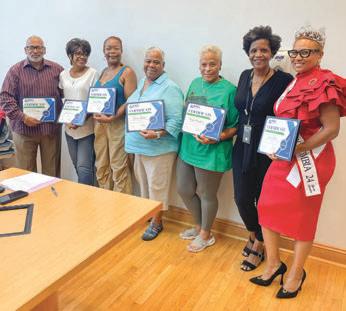
Last Month, we were able to train a new cohort of DACL Senior Ambassadors. The DACL Ambassador Program is an initiative designed to train community residents on the programs and services offered by the DC Department of Aging and Community Living. Ambassadors serve as key contacts in their wards and communities, sharing information and connecting seniors, people with disabilities, and caregivers to the resources available to them. If you are interested in becoming an Ambassador and attending an ambassador training, please email us at dacl.communications@dc.gov.











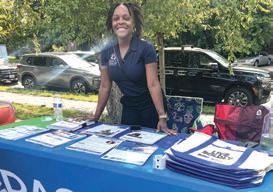





DACL participated in National Night Out with DC’s Metropolitan Police Department earlier last month. National Night Out enhances the relationship between neighbors and law enforcement while bringing back a true sense of community.
Director’s message from page 26
tions with family, friends, and community groups to foster a sense of belonging and emotional well-being.
• Get Regular Check-Ups: Visit your healthcare provider regularly to monitor your health and catch any issues early.
• Manage Stress: Practice relaxation techniques like meditation, deep breathing, or engaging in hobbies you enjoy to reduce stress.
• Plan for the Future: Manage your finances and ensure your long-term needs are met.
• Keep Your Mind Sharp: Challenge your brain with puzzles, reading, or learning new skills to stay mentally engaged.
In addition to adopting healthy habits, this month is also a time to celebrate the many triumphs of







DACL joined the DC Department of Parks and Recreation for the 10th annual Chuck Brown Day, filled with fun, music, and community!


DACL seniors having some fun in the sun at DPR’s Senior Drip


aging. On September 18th, we will honor the District’s oldest residents—those aged 100 and over— at Mayor Bowser’s 38th Annual Centenarian Salute. This momentous occasion gives us the opportunity to celebrate the life accomplishments of DC Centenarians. Even if you’re not a centenarian (yet!), I invite you to join the celebration by checking in on a centenarian in your community. You never know what lessons—or even secrets to reaching 100— you might learn.
Continuing our recognition of Healthy Aging Month, seniors across the District will compete in the 7th Annual Brain Games. This citywide triviastyle game will feature teams from all eight wards competing for the title. We invite you to join in the fun! The Annual Brain Games will take place at Martin Luther King, Jr., Library on Wednesday, September 25th at 10:00 a.m.
As we move forward in celebrating Healthy Aging Month, I want you to remember that aging is a journey and it is never too late to start making positive changes. Whether it's staying active, eating well, or staying connected with your community, every step you take brings you closer to a healthier, happier life.
Thank you for being a part of our vibrant community and for your continued commitment to Living Boldly. We are here to support you every step of the way. If you have any questions or need assistance, please don't hesitate to reach out to DACL at (202) 724-5626, www.dacl.dc.gov, or download the DACL app. Let’s make this Healthy Aging Month one to remember!
In Service, Charon P.W. Hines Director, Department of Aging and Community Living

By Adriana Morga
If you’ve noticed that you’re paying more than before for the same amount of groceries, you’re not the only one. Inflation is easing slightly, but grocery prices are still high — up 21% on average since inflation started to surge more than three years ago.
Unlike some other items, you can’t just stop buying groceries when they get pricey. There’s nothing you can do about inflation, but you can find ways to save on groceries so they don’t heavily impact your wallet or your eating habits. These include using coupons, budgeting and buying in bulk.
Here’s are some expert recommendations for saving on groceries:
Kiersten Torok started using coupons back when she was in high school, after her parents lost their jobs during the 2008 recession. She began relying on them even more in 2020, when she lost her own job during the pandemic.
Now she’s using her social media platform to help others learn how to save. “When times like these come up, coupons are a necessity for so many Americans,” said Torok, known on Instagram and TikTok as Torok Coupon Hunter.
Many might think that using coupons means cutting them out of a magazine. While you can certainly still do that, there are now easier ways to get the discounts.
Many stores, like Walmart and Target, have coupons available on their apps.
“All you have to do is scan an item in a store, the coupons pop up on your app, and then they automatically apply at the register,” Torok said. “It’s become much more streamlined.”
One of Torok’s coupon golden rules is: never pay for toothpaste — there’s always a combination of coupons and offers available.
For anyone who wants to try couponing, Torok recommends that you first start using them at your favorite store, and never buy things you don’t need, even if there’s a big discount.
Apps like Flipp, which lets you browse for coupons from all major grocery stores, and Ibotta, an app that gives you cashback for using coupons, can make your journey with couponing easier.
Making a budget is a key to keeping grocery spending under control, and the first step is to track how much you’re already spending. Start by reviewing how much you have spent on the last few times you’ve gone grocery shopping, recommended David Brindley, deputy editor for AARP Bulletin.
If you don’t keep receipts from past grocery runs, try looking at your bank account statement and adding up the grocery charges.
Once you know how much you spend on groceries, set a goal, for example, stay-
ing within a specific budget or reducing your spending.
You need a plan, but before you make one, ensure you know what you currently have in your fridge and your pantry.
Sarah Schweisthal, personal finance expert and social media manager at budgeting app YNAB, recommends taking everything out and making an inventory so you don’t buy duplicates of things you already have on hand.
Brindley also recommends planning to cook multiple meals with similar ingredients, which saves money and also cuts down on food waste.
Once you’ve tracked your spending and inventoried what you already have, the next step is to make a plan. Write down the items you’re looking to buy and their estimated cost, making sure you stay on budget.
Meal planning for the week or month can be a good way to stay on top of your spending, Schweisthal said.
Going up and down the aisles can sometimes make you crave things that you haven’t planned for, like a snack or a new dish. If you foresee that it’ll be hard for you to stick to your list, include some flexibility in your plan, such as allotting a specific amount to buy snacks or a random item you see at the checkout line.
“I think having flexibility in a plan actually helps you stick to it more,” Schweisthal said. Making a plan can be as simple as writing down a list on paper or in your phone’s notes app. Or you can use apps that specifically help you with meal planning, such as AnyList or Mealime.
If you tend to wander off your grocery list because every time you go to the store you buy things you don’t need, shopping online and picking up curbside is a good workaround.
“I 100% recommend sitting down Sunday morning and just looking at the stores and comparing the items you need for the week, especially with things you can get for curbside pickup,” Torok said.
If you buy your groceries from multiple stores because each has better prices on some items, ordering ahead of time can also save time.
Since buying in bulk can be very cost-effective. Brindley recommends that you team up with a friend or a family member to buy specific items in bulk and share the discount.
Lastly, you can save money by using food-sharing apps such as Olio, which connects people around their community to share extra grocery items, and Too Good to Go, where you can buy surplus food at a discount.
By Ella Vincent
Even if your estate plan is in order, it won’t be of much help to your heirs if they can’t locate important documents when you’re no longer around.
Organizing your financial and estateplanning documents — and letting your family know where you’ve stored them — will make it easier for your loved ones to care for you if you become incapacitated, and it will smooth the process of settling your estate after you’re gone.
Plus, while you’re still alive, you’ll be able to quickly track down paperwork.
Start with a file
To organize your records, you can use
an accordion file or binder and divide the documents into different categories, such as estate planning, life insurance policies, property titles and investment statements.
You should also include categories for health insurance, long-term-care insurance, and bank account and credit card information. That way, your family will have the details they need to pay medical bills if you’re hospitalized for a long period.
Use Microsoft Word or Google Docs to write down additional details — such as who you want to take care of your pets, a list of subscriptions and memberships, and passcodes to any home security systems or online accounts.
Once you draw up the documents, print
them and place them in your binder. (You can also store them digitally — more on that below.)
Store your documents in a secure area, such as a locked filing cabinet or fireproof safe in your home. Make sure your loved ones know the location of your cabinet or safe, and give them any keys, combinations or codes required to access it.
If you don’t want to keep the documents in your home, you can entrust them with your estate lawyer, said George Taylor, estate attorney with Brinkley Morgan.
“Your estate attorney can store original documents, like your will and titles to your
house and car. Then you and the executor of your will can have copies,” he said. You can put copies of your will and other important documentsin a safe-deposit box, but it’s usually not a good idea to keep originals there if you’re the sole owner.
After your death, the bank will seal the safe-deposit box until an executor can prove he or she has the legal right to access it. That could lead to long and potentially costly delays before your will is executed.
You should keep original, paper versions of your will, power of attorney and other
By Cora Lewis
U.S. stocks are bouncing back after the market experienced its worst day in two years last month, but the average investor may still be understandably spooked. Over a three-day losing streak, the S&P 500 dipped more than 6% before rallying again the next day, up 1.6% in midday trading.
“This is what an emotion-driven market looks like,” said Mark Hackett, head of investment research for Nationwide. “You had a three-day period [in August] that was really very challenging. But the drop was not justified by the data that was out there, which is why you then have a [period of rebound].”
For everyday people, what are the best ways to handle market volatility? The top advice is to do nothing. But ultimately your response depends in part on your circumstances and financial goals.
“It’s important to remember that investing in the stock market is a long game. There’s going to be volatility, so be wary of having a knee-jerk reaction and pulling your money out at the first sign of a drop,” said Courtney Alev, consumer advocate for CreditKarma.
“Selling stocks frequently or incrementally can come with fees for each transaction, and those can add up fast.”
Caleb Silver, editor-in-chief of Investopedia, echoed this, cautioning that sellers
may also end up owing taxes on any gains.
“For everyday investors, volatility is the price you pay to be invested in the stock market,” Silver said. “But it’s very unsettling when we see big market drops of two to three percent…It’s a little unnerving for people who have their money in 401(k)s or IRAs or retirement funds to watch this magnitude of volatility.”
Silver urged investors to remember that “a market falls into a correction [Ed. Note: a drop of more than 10% but less than 20%] once a year on average. Usually the market reverts to the mean, and the mean is an average annual return of 8 to 10% a year, going all the way back to the 1950s.”
In fact, declines in the stock market can be seen as an opportunity to add to your portfolio at cheaper prices, by buying in when the market is falling or has fallen a lot, according to Silver.
When you buy in a down market, “You’re reducing the average price you pay for the securities, stocks, mutual funds or index funds that you own,” Silver said. “So when the market itself reverts to the mean and rises again, you [will have taken] advantage of having bought at cheaper prices, and that adds to the value of your portfolio.”
In terms of selling, though, he said the best advice for most investors is to do noth-
ing and wait for the volatility to cool down.
Some investors may want to re-evaluate their comfort level, however.
“Whenever you invest in stocks it’s important to be mindful of your time horizon,” Alev said. “For instance, do you expect you’ll need to liquidate in the near future? In that case, you’re likely better off opting for a less volatile and more riskaverse mode of growing your money, such

as a high-yield savings account.”
Silver agreed. “I don’t believe it when people say, ‘Don’t look at your 401(k),’” he said. “You should absolutely look and see what you own and see that it matches your risk appetite.”
If it doesn’t, you can move your investments to products that can shield you from the ups and downs of the market or unforeseen events. Silver noted that high yield








I’m a Seniors Real Estate Specialist® who is steeped in knowledge and experience. My unique marketing and master
qg negotiating are wrapped up in kindness, honestyy, , and protective care. I guide you in how to sell for top dollar while supporting you with the very best resources.
Whether you want to remain in your home, or move to a ement community retir y, , I am the guy you want to call.



For your free copy of m “Rightsizing Guide” or “Senior Living Guide,” them from the “Resour
section of EricStewartG or call me directly at (301) 252-1697 for a pe consultation on your re estate needs.
Listen to my week radio show,
Getting Older w Eric Stewart every Sunday fro 12:30 – 1:00 p.m on WMAL 105.9 FM insights into living w while getting olde
kly with t m m. M for well er.
From
key estate-planning documents. But if you’d like to create a backup of your paper documents, consider using a flash drive (which you can plug into your computer’s USB port) to collect them all in one place.
Alternatively, you can use a cloud storage system, such as Microsoft’s OneDrive or Apple’s iCloud. OneDrive’s free version gives you 5 gigabytes (GB) of cloud storage. Its family version, which allows up to six individuals to share and access documents, costs $99.99 a year.
Apple’s iCloud Drive also provides 5GB of free storage. For 99 cents a month, you can upgrade to iCloud+, which provides 50GB of storage, and you can share it with up to five family members.
Whichever option you choose, protect documents in the cloud by creating strong passwords and adding two-step verification [Ed. Note: which may, for example, require you to reply to an email or text mes-
savings accounts, certificates of deposit and money market accounts are all currently seeing returns of about 4% to 5% for the more cautious or conservative investor.
Nationwide’s Hackett said it makes sense to periodically rebalance the exposure one has in their portfolio in general —whether quarterly or annually — to make sure there isn’t more risk than one would want related to, say, technology stocks or another sector.
“If your exposures get out of line with your long-term plan, get them back in line,” he said. Even so, Hackett added that he sees the trend of tech stocks outperforming [other stocks] as one that may extend further into the future.


sage to gain access].
Your heirs will need passwords to log in to your online accounts, so make sure they have easy access to them [Ed. Note: and to any device they might need for two-step verification].
You can write them down in a document to store in your binder, or use a secure password-management tool. A family membership to 1Password ($4.99 a month after a two-week free trial) offers shared account access for up to five family members. With Bitwarden, you can share your account with one other person free. Or sign up for a family membership ($40 a year), which allows access for up to six people.
Update your documents each time you have a life change. For example, you may need to alter the beneficiaries in your will or life insurance policies if you get divorced or have grandchildren, and living trusts should be updated to reflect the purchase or sale of property included in the trust.
Experts agree that, for investors with debt, it’s important to focus on paying off loans, especially high-interest ones, before making major investments.
That said, according to Silver, “if you are able to simultaneously pay off your loans and invest a little bit at the same time, you are effectively paying your future self for being responsible about your debt while growing your investments over time.”
AP
The Associated Press receives support from Charles Schwab Foundation for educational and explanatory reporting to improve financial literacy. The independent foundation is separate from Charles Schwab and Co. Inc. The AP is solely responsible for its journalism.





Even if you haven’t undergone any big changes, check your documents at least once a year to make sure the information is current.
If you entrusted your estate attorney with your documents, he or she can also help you keep them up to date, Taylor said. Ask your estate attorney to send you an annual email or letter reminding you to update your information, and make sure the right person is still in charge of your affairs, he said.
Make sure to include the following information in a binder or digital file:
• Will or trust
• Powers of attorney for finances and healthcare
• Organ donation form
• Living will
• Letter of instruction for your heirs
• Beneficiary designations
• HIPAA release (allows healthcare providers to share information about you with authorized individuals)
• Bank and financial statements
• Real estate deeds and titles
• Retirement account documents
• Life insurance policies
• List of important personal property, such as jewelry and artwork, and estimated values
• Funeral instruction
Note: This article first appeared in Kiplinger Personal Finance Magazine, a monthly, trustworthy source of advice and guidance. Subscribe to help you make more money and keep more of the money you make.
All contents © 2024 The Kiplinger Washington Editors, Inc. Distributed by Tribune Content Agency, LLC.
— Cynthia R
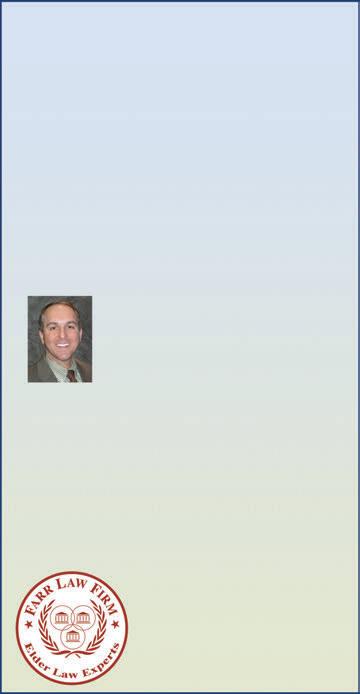

By Christian Wardlaw
If you’re ready to move on from a purely gasoline-fueled vehicle but you’re not ready to go fully electric, you have two choices. You can get a hybrid or a plug-in hybrid vehicle.
But which one is best? The experts at Edmunds will help you decide.
What a hybrid car offers
A hybrid electric vehicle has a gasoline engine, a small electric motor and a small battery pack that work together to improve fuel economy, enhance performance or both.
Sept. 28
The best-known hybrid is the Toyota Prius, but they come in all shapes and sizes. From compact cars to full-size pickup trucks, there is a hybrid for just about anyone.
Pros
• Improves fuel economy while reducing emissions
• Sometimes improves acceleration and overall performance
• Often provides electric-only driving at low speeds for short distances
• Usually doesn’t reduce passenger or cargo space
• Never needs to be plugged in
Check out the latest in hearing assistive technologies, apps, local county services, hearing aids, tinnitus, cochlear implants, captioning, ASL classes, ENTs, audiologists and more at the NV Resource Center for Deaf & Hard of Hearing Persons’ free information fair. The fair has 30+ exhibitors and returns to the Springfield Town Center, 6500 Franconia-Springfield Pkwy., Springfield, VA, on Sat., Sept. 28 from 11 a.m. to 3 p.m. Use the main entrance between Yard House & Maggiano’s restaurant; event is on the lower level, by Lego store and Starbucks. For more info, email Bonnie O’Leary at boleary@nvrc.org or call (703) 352-9055, ext. 106.
• Small increase in price, if any
• Reduced fueling costs
Cons
• Cannot travel long distances solely on electricity
• Cannot travel at higher speeds only on electricity
[Ed. Note: Battery packs have a long, but limited, lifespan and are expensive to replace. You cannot drive a hybrid without a functioning battery. This applies to both hybrids and plug-in hybrids.]
Overall, a hybrid electric vehicle is a great choice for anyone who wants better fuel economy, reduced emissions, and lower operating costs without any extra hassle or change in their daily routine.
Hybrids are more commonly available than ever, and some automakers are using only hybrid powertrains on their new models.
For example, every version of the 2025 Toyota Camry is a hybrid, and Honda offers certain versions of the Accord, Civic and CR-V only with hybrid power. Hybrid versions of many other popular models, such as the Kia Sportage and Hyundai Tucson SUVs, are also available.
a plug-in hybrid differs
A plug-in hybrid vehicle, often abbreviated as PHEV, is a hybrid that offers elec-
tric-only driving for a short range and can then be plugged in to recharge.
They have a gasoline engine like a hybrid does, but thanks to a larger and more powerful electric motor and battery pack, they can travel at a wider range of speeds in electric mode for many miles at a time. When the battery charge gets low, the gas engine turns on to continue the trip. You can recharge a plug-in hybrid using a household electrical outlet or a charging station.
Pros
• Electric-only driving for commuting, taking the kids to school, running errands, etc.
• Gas-only driving for longer trips
• Can charge the battery overnight using a household-style outlet or in a few hours using a more powerful charging station
• The gas engine automatically takes over to power the vehicle when the battery charge is low
• Can dramatically improve fuel economy, acceleration and overall performance while reducing operating costs
• Certain models may qualify for a federal tax credit of up to $7,500
• May qualify for carpool lane access in certain states with only a driver aboard
See EVs & HYBRIDS , page 33
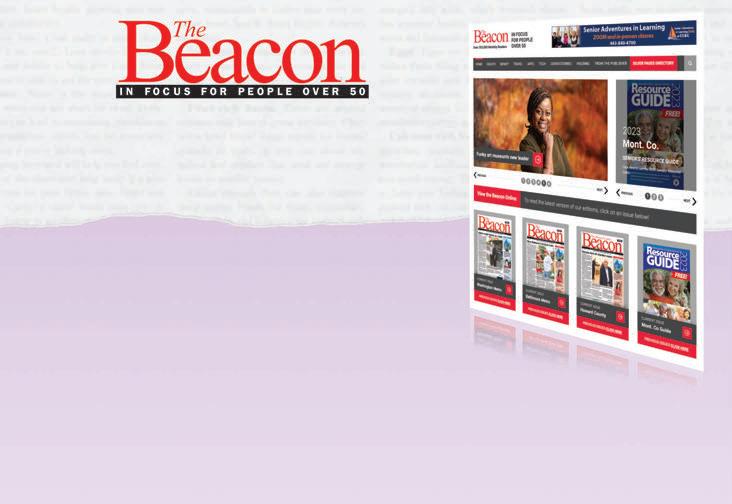



From page 32
Cons
• A plug-in typically costs substantially more than a hybrid or gas-only vehicle
• Plugging in each night can seem like a hassle
• The larger electric motor and battery may reduce passenger or cargo space
• The added weight of plug-in hybrid components can negatively affect the ride and handling
• If you don’t make a habit of plugging in, it may be less efficient than a hybrid Plug-in hybrids are perfect for people who want an electric vehicle but worry about driving range, public EV charging infrastructure, and the costs of installing a home charging station.
They’re easy to recharge overnight, usually offer enough electric range for typical daily driving, and have a gas engine that eliminates the range anxiety common with driving an EV.
For example, you can drive a plug-in hybrid from Manhattan to Santa Monica and never plug it in. Or, when you’re not taking a longer trip, you can plug a plug-in hybrid in every night and hardly burn any gas in
everyday driving, especially if you choose a model with a generous electric-only range.
In short, a plug-in hybrid represents the best of both worlds — a perfect bridge from the gasoline past to the electric future. Examples of plug-in hybrids highly rated by Edmunds include the Chrysler Pacifica Hybrid, Hyundai Tucson Plug-in Hybrid, Toyota Prius Prime and Volvo XC60 Recharge.
Choosing between a hybrid vehicle and a plug-in hybrid vehicle comes down to three things. First, do you want the ability to drive only on electricity? Second, are you willing to pay more for a vehicle in order to get that? Third, are you willing to put up with some extra hassle to maximize electric-only driving?
If your answers to those questions are “no” and your only goal is to save money at the fuel pump, we recommend a hybrid. But if you want to eliminate as much gasoline use as possible without diving into the deep end of the electric vehicle ownership pool, a plug-in hybrid is perfect. This story was provided to The Associated Press by the automotive website Edmunds.
Senior Planet from AARP hosts this presentation on protecting your personal information online, including tips for staying safe in cyberspace, secure browsing, recognizing online scams and more. The free event takes place on Wed., Sept. 18, from 3 to 4 p.m. at the Silver Spring Recreation and Aquatic Center, 1319 Apple Ave., Silver Spring, MD. Registration isn’t necessary. For more information, call (240) 777-6900.
Enjoy a walk with the Seneca Valley Sugarloafers Volksmarch Club on Sat., Sept. 28 starting between 9 a.m. and noon and ending at 3 p.m. Come to the Frederick Fairgrounds, 797 E. Patrick St., Frederick, MD. Trails are wheel-friendly. Walkers over age 12 pay $4. For more information, visit sugarloafers.org or call (301) 828-5257.

ALZHEIMER’S FOUNDATION HELPLINE
Have questions about Alzheimer’s disease? Connect with licensed social workers seven days a week through the Alzheimer’s Foundation of America’s National Toll-Free Helpline. Call 1-866-2328484, text (646) 586-5283, or web chat at alzfdn.org by clicking the blue and white chat icon in the right-hand corner of the page. Web and text help are available in more than 90 languages.
DRINKING WATER SAFETY WEBINAR
Learn about the minerals, metals and other contaminants that may be present in both public and private well water supplies and the health concerns they pose. This free online webinar from the University of Maryland Extension also provides treatment options for common water contaminants. The webinar takes place on Wed., Sept. 18 from noon to 12:45 p.m. For more information, contact Andrew Lazur at (301) 789-5256 or Lazur@umd.edu. To register and receive a link, visit bit.ly/WaterContaminantsWebinar.





























By Martha Steger
Standing in an olive grove in southwestern Spain, I felt a bit like Moses raising his staff and parting the Red Sea.
Stick in hand, I struck an olive tree’s large limbs, and voila! A hail of ripe, green olives thundered to the ground. How different this was from the slow picking of blueberries, strawberries and even peaches on my family’s farm on Virginia’s Eastern Shore.
Travel experiences such as olive harvests needn’t be like going to the theater and watching others do it. They can — and should — have a participatory component.
After decades of traveling, I had that epiphany a few years ago: Firsthand experiences, beyond talking to the locals, are what make or break our travels.
Last September, after a conference in Madrid, five other journalists and I sought out a long weekend in the olive-growing region of Extremadura.
The bonus, it turned out, was that the area has more Roman ruins than anywhere else in Spain. We combined traditional sightseeing with hands-on experiences for an ideal getaway.
Extremadura’s capital, Mérida, helped us understand the development of a European city from its beginnings 2,000 years ago.
Here, in the westernmost province of
ancient Rome (founded in the first century B.C.E.), we spent a full day strolling among sites, including Early Christian basilicas.
Most memorable was our five-minute walk covering more than a thousand years historically and architecturally. We went from Plaza de España to a half-mile-long bridge — the Puente Romano — spanning the Rio Guadiana.
The later Muslim era is also represented, as the bridge adjoins Alcazaba, an 11th century Islamic fortress built over Roman walls.
City founders seem to have had us 21 century visitors in mind by building spectacular sights such as the Roman Theatre and the Temple of Diana close to the scenic bridge.
We jaw-dropped at the Archaeological Ensemble of Mérida, built when Augustus completed the conquest of the north of Hispania in 25 B.C.E. He intended this farflung post of the Roman Empire to present as an idealized model of Rome.

Approximately halfway (an hour’s drive) between Mérida and our more hands-on destination in Villamiel was Cáceres, a medieval walled city and province that’s a UNESCO World Heritage site.
No traveler can do everything on one trip, and I knew this place merited a return to cover Roman and Moorish occupations, as well as the Golden Age of Jewish culture in Spain.

Picnicking in olive groves “Un-touristy” was how one of my travel companions described Villamiel, with its iffy internet service, lack of box stores, and few visitors to the municipality with fewer than a thousand inhabitants.
Cáceres was the closest population center to our rural accommodations for the next three nights — the olive mill-turnedfour-star-resort named Hotel Aqua et Oleum (Water and Oil). The hotel reflects the countryside: rustic and elegantly charming for its authenticity in presentation and service.
A decade ago, an American entrepreneur, Joseph Shortell, saw the potential in the dilapidated structure with worn stones and water wheel. In restoring the place, he preserved as much as possible of the olive mill while renovating spaces into attractive guestrooms and adding a fine chef and concierge.
Among the three dinners we enjoyed were pork cheek prepared in a stew with a seasonal fruit sauce, and semolina with walnuts. A dessert featured fresh pears cooked with pepper, cumin, honey and raisin wine — recipes worthy of internet viral distribution, if we could get online.
Our full breakfast might be crepe-like scrambled eggs with Spain’s artisanal ham
or scallion pancakes. For lunch, we picnicked on farm food either on the grounds (after striking olive trees to gather fruit) or at a nearby olive grove: charcuterie with fruit, crusty baguette and wine.
With an olive culture from trees to oil, Extremadura is about community connection. At an olive-processing plant, we witnessed a long line of cars packed with crates of homegrown olives to be pressed into oil — which, for an extra fee, might bear the label of the individual grower or family.
It’s not all work and no play: We couldn’t help but notice how often locals in the nearby towns of El Gasco, Asegur and Casares de las Hurdes laughed as they enjoyed shopping, dining, drinking and conversing with one another. That’s reason enough for a return trip.
If you go
Round-trip flights to Madrid in September start at $590. Prices vary with currency values, but it’s wise to budget an inclusive $2,500 per person for a weekend of three nights, including transportation to and from the Madrid airport, a Mérida stopover and visits to nearby sites while in Villamiel.
For travel resources, visit turismoextremadura.com/en/index.html.
By Victor Block
As I drove into the tiny town of Oxford, Maryland (population about 600), I immediately began to relax. My breathing slowed, my body slouched, and when I turned to glance at my wife, Fyllis, seated beside me, she was having the same reaction.
We were looking forward to leisurely exploring the minuscule municipalities scattered about Talbot County to immerse ourselves in bygone days.
Locals pronounce the name of their county in several ways. We heard it called Tahl-but, Tall-but and Taw-but. However you say it, the destination offers a deep dive into intriguing chapters of our country’s past.
Captain John Smith surveyed the region in 1608. Indigenous people who lived in the area maintained good relations with the first English settlers, who arrived in the 1630s, and over time were assimilated into their culture through intermarriage.
The English established tobacco plantations and formally created Talbot County in 1662. The enclave was named for Lady Grace Talbot, sister of the second Lord Baltimore.
He is remembered for instituting freedom of religion and separation of church and state, first in Newfoundland and
Labrador in present-day Canada, and then in the Maryland colony.
Many early immigrants were Quakers or Puritans seeking a haven from persecution, or people from Ireland and Scotland transported to the colony as indentured servants. Adding to the mix were both free and enslaved African Americans.
Fyllis and I were delighted to learn that each town in Talbot County has a museum that relates its history.
The Tilghman Watermen’s Museum, for instance, celebrates the work and culture of people who earn their livelihood on rivers and bays. Occupying what once was the island’s barbershop, the museum brings their stories to life with videos, boat models, tools of the trade and art.
The centerpiece of the Oxford Museum is a lighthouse lens named for AugustinJean Fresnel, a French engineer who, in the 1820s, invented a lens that intensifies light. Other exhibits are devoted to oysters, ducks and watermen.
This region is home to the oldest Black community in the United States, and you’ll find museums, trails and other references to this history. The Water’s Edge Museum in Oxford portrays the lives of Black farmers, watermen, sailmakers and others who

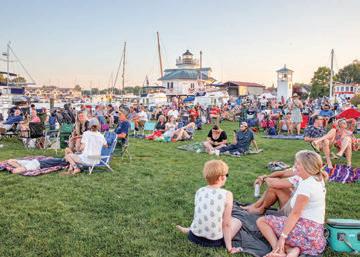
In July, 1,500 people attended Big Band Night on the 18-acre campus of the Chesapeake Maritime Museum in St. Michaels, Maryland. The facility tells the stories of the Chesapeake Bay, and features a lighthouse, hundreds of historic boats and artifacts, and educational river cruises.
played important roles in the area’s commerce and culture.
Our favorite museum was the Chesapeake Bay Maritime Museum in St. Michaels, an 18-acre campus that has evolved from a humble beginning into a world-class display. Fyllis and I marveled
at the historic structures, more than 100 boats and boat models, decoys and a relocated lighthouse.
St. Michaels was founded in the mid1600s as a trading post for trappers and




Help the Montgomery County Humane Society raise funds while enjoying a meal. Order from Potomac Pizza, 9709 Traville Gateway Dr., Rockville, MD, on Wed., Sept. 18 from 4 to 9 p.m. and have 20% of your purchase go to helping animals when you mention MCHS. For more information, call (301) 279-2234. Order from Chipotle, 865 Rockville Pike, Ste. B, Rockville, MD, on Wed., Oct. 2 from 5 to 9 p.m., and 25% of sales go to MCHS. Use code G7LQ67 or use the flyer at bit.ly/ChipotleMCHS.
Curious about saving seeds for your garden? Join Master Gardeners online on Fri., Sept. 20 from 10 to 11:30 a.m. to learn when and how to save seeds, which ones are likely to be reliable, and which ones may surprise you. Choose wisely, and you may develop your very own heirloom strain. This event is free. To receive a link, RSVP at bit.ly/MGNVclasses. For more information, call (703) 228-6414.
The American Red Cross is experiencing a national blood shortage. There is an emergency need for platelet donors and type O blood donors, but donors of all blood types are needed. To schedule an appointment or find upcoming blood donation drives, visit RedCrossBlood.org or call 1-800-RED CROSS.
From page
tobacco farmers. It later became a shipbuilding center.
One major claim to fame relates to the British Navy’s bombardment during the Battle of 1812. Townspeople turned off their house lights and hung lanterns in nearby trees, at which the Brits aimed their cannons. That trick resulted in St. Michaels becoming known as “the town that fooled the British.”
Serene, charming Oxford
Fyllis and I chose Oxford as our home base for a variety of reasons, including its serene setting. Officially established in 1683, this is a charming town of brick sidewalks, white picket fences and elegant historic homes.
In Colonial days, Oxford became a booming port, and later an active boatbuilding business thrived there. Much
The Greens at Hammonds Lane: 410-636-1141
Park View at Furnace Branch: 410-761-4150
Park View at Severna Park: 410-544-3411
BALTIMORE CITY
Ednor Apartments I: 410-243-0180
Ednor Apartments II: 410-243-4301
The Greens at Irvington Mews: 410-644-4487
Park Heights Place: 410-578-3445
Park View at Ashland Terrace: 410-276-6440
Park View at Coldspring: 410-542-4400
BALTIMORE COUNTY
Cove Point Apartments I: 410-288-2344
Cove Point Apartments II: 410-288-1660
Evergreen Senior Apartments: 410-780-4888
The Greens at English Consul: 410-789-3000
The Greens at Liberty Road: 410-655-1100
The Greens at Logan Field: 410-288-2000
The Greens at Rolling Road: 410-744-9988
Park View at Catonsville: 410-719-9464
Park View at Dundalk: 410-288-5483 • 55 & Better
Park View at Fullerton: 410-663-0665
Park View at Miramar Landing: 410-391-8375
Park View at Randallstown: 410-655-5673
BALTIMORE COUNTY (CONT.)
Park View at Rosedale: 410-866-1886
Park View at Taylor: 410-663-0363
Park View at Towson: 410-828-7185
Park View at Woodlawn: 410-281-1120
EASTERN SHORE
Park View at Easton: 410-770-3070
HARFORD COUNTY
Park View at Bel Air: 410-893-0064
Park View at Box Hill: 410-515-6115
HOWARD COUNTY
Park View at Colonial Landing: 410-796-4399
Park View at Columbia: 410-381-1118
Park View at Ellicott City: 410-203-9501
Park View at Ellicott City II: 410-203-2096
Park View at Emerson: 301-483-3322
Park View at Snowden River: 410-290-0384
PRINCE GEORGE’S COUNTY
Park View at Bladensburg: 301-699-9785 • 55 & Better
Park View at Laurel: 301-490-1526
Park View at Laurel II: 301-490-9730
later, the author James Michener chose it as the place where he wrote his novel
Chesapeake
Oxford also is notable for two other reasons. One is the Robert Morris Inn, built in 1710 as a home and operating as a venerable hotel since 1800. Yes, George Washington slept here, as did Robert Morris, a British-born merchant and banker who helped finance the American Revolution and signed the Declaration of Independence.
The town also is home base for the Oxford-Bellevue Ferry, the oldest privately owned ferryboat in the country. It began transporting passengers in 1683 and now carries vehicles, trailers, bicycles and motorcycles across the Tred Avon River.
While we didn’t ride the ferry, we drove across a short drawbridge to the tiny waterman’s village of Tilghman Island (pronounced Till-man), retracing the route of spans that have existed at that site since the late 1600s.
Across the bridge, a 40-foot-tall mural titled “Pride” depicts a waterman in his boat with other vessels docked nearby, as well as displays of the seafood for which Talbot County is rightly famous.
A plaque pays tribute to the people “who have been working the Chesapeake Bay waters since the 1800s,” demonstrating and facing “Endurance. Perseverance. Hard Work. Ingenuity. Danger. Drive. Respect for the natural world.”
In this quiet place of beauty, respect for nature comes easily. Talbot County has more than 600 miles of shoreline, so we were never far from water.
We scanned the rivers and the bay, hoping to glimpse eagles, ospreys, cownose rays, bottlenose dolphins or even a bull shark. While we weren’t lucky enough to see rays or sharks, we did spot dolphins and fish and even an osprey gliding through the air.
For more information, visit tourtalbot.org or call (410) 770-8057.
Georgetown Heritage is offering a new walking tour of the
beginning in September. The tour, “Industry & Innovation,” lasts about 90 minutes, meets and ends at the Georgetown Visitor Center, 1057 Thomas Jefferson St., Washington, DC, and runs Thursday to Sunday at 10 a.m. and 2 p.m. daily.
Participants should be prepared to traverse uneven surfaces and walk up stairs. Tickets are $25 for adults; $20 for educators, military and children 12 and under. For more information and to schedule a tour, visit GeorgetownHeritage.org.

































































You either experienced the July airline meltdown or read about or viewed some of the grief it caused, and you’re wondering what to do to make it easier if it happens again.
The short answer is “not much.” It seems that airline computer systems are not the most robust on the planet, and if they’re down, you can’t even reach the airline to try to arrange a fix. You have to wing it — not a very helpful suggestion, but a realistic one.

By Ed Perkins
In reviewing your options, start with figuring out exactly what your airline owes you. And here, the airlines draw a big distinction between difficulties caused by something within their control and those caused by some external cause.
Specifics are included in each airline’s contract of carriage, but the Department of Transportation (DoT) conveniently posts a “dashboard” on its website showing what each of the 10 large domestic scheduled
lines and their regional partners offers in the event of significant controllable cancellations and delays. DoT defines a significant delay period as three hours.
All lines promise to rebook you on one of their own flights, and all promise a meal or meal voucher. All except Frontier promise a hotel room if the delay extends overnight.
However, the DoT dashboard covers only what you’re due if the delay/cancellation is caused by a “controllable” problem. And airlines are pretty good at defining problems as not being under their control.
When almost everyone’s computer system goes down, that’s probably not controllable, but if only one airline has IT problems, that’s probably controllable.
The DoT dashboard reflects what an airline owes you if you wish to keep trying to get to your destination.
If the airline cancels your flight for any reason, controllable or not, you can refuse its suggested alternative and get a full cash refund. If the problem is not controllable, that’s all you get if your airline cancels.
Keep in mind that trip-interruption insurance won’t save your day or ease the snarl. It pays for extra expenses of getting you home, but it doesn’t find the airline seats you need to get there. As I’ve noted so often, travel insurance helps with the money, not the experience.
Overall, my approach to a snarled airline system is to get my refunds, cancel downstream reservations, and go back home until the snarl is resolved.
If you can’t do that, you have to tough it out — or else rent a car to complete your trip, if that last segment is short enough.
The DoT dashboard covers only domestic airlines. If you’re on a flight within the European Community (EC) or originating in the EC on any airline, and into the EC on an EC-based airline, EC Rule EU261 requires your airline to provide additional compensation and assistance, including cash compensation.
Moreover, the rule limits what an airline may claim to be non-controllable. Overall, EC flyers are better off than those in the U.S. (There’s a good summary of the ben-

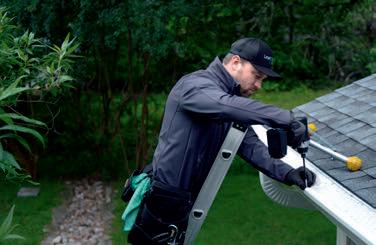

efits of this rule at bit.ly/ECflights.)
To reduce your risk
If you haven’t firmed up plans for a fall trip, you’re probably considering ways to minimize risks — personal and financial — of some future meltdown.
Here are two ideas:
• Take direct flights: The best way to minimize risks of dealing with a snarled system — for any reason — is to avoid connecting flights or at least avoid the largest mega-hubs. News reports clearly revealed that the worst grief in the recent meltdown struck travelers at hub airports. So even if nonstops are more expensive or require using less convenient airports, avoiding a hub connection or a hub is a big plus. [Ed.
Note: Major hub airports include Dulles, O’Hare, JFK and LAX.]
• Buy travel insurance: The best way to avoid financial risk is to minimize prepayments and deposits that are either nonrefundable or carry stiff cancellation penalties. If you can’t avoid putting a lot of money up front, buy trip-cancellation insurance.
Email Ed Perkins at eperkins@mind.net or visit his rail travel website at railguru.com.
© 2024 Ed Perkins. Distributed by Tribune Content Agency, LLC.




By Michael R. Pope
The 1980s sitcom “Cheers,” about a small Boston bar “where everybody knows your name,” seems to be alive and well in Wheaton, Maryland — minus the beer.
Nick’s Diner, nestled at the intersection of Veirs Mill Road and University Boulevard, attracts a cast of regulars who know each other’s names. For more than 42 years, generations of customers have enjoyed its hearty food and cozy atmosphere, connecting through their life’s journeys.
“This is the breakfast ‘Cheers,’ where everyone knows about each other’s lives and families, and their words travel down the counter from one guy to the next,” said George Markopoulous, whose parents, Nick and Sophia Markopoulous, opened the restaurant in 1982, when their children were teenagers.
Now George and his sister Heather operate the diner, and Nick has retired. He recently celebrated his 75th birthday on July 22 at the restaurant.
The place is packed on weekends and only opens for breakfast and lunch during the week. According to George, the family’s business philosophy is based on people-to-people interactions and employee satisfaction.
“We have employees here who have been with us for more than 23 years. People come to see the staff and their other friends to keep up with life. This is an extended family operation we run, more so than a numbers operation,” he said.
Pancakes, omelets and coffee normally keep the cash register humming, but on Nick’s birthday, free meals were the order of the day, thanks to longtime patron Dave Carter.
“This is my way to give back to the community and celebrate life. I’m not a millionaire, and I’m not poor,” Carter said.
The 83-year-old Carter, who shares his birthday with Nick, has been coming to the diner six days a week for the past 10 years.
“This is Americana at its best,” Carter said. “It’s a meeting place. It’s not Nick’s and George’s Diner; they may own it, but it’s the people’s diner,” Carter said.
The age demographic at Nick’s spans several generations, from 8 to 85 years old. Somehow, they all talk to each other, and conversations among strangers spark easily.
Some come to be at peace and to read, some rely on the consistency of the comfort food, and others seek the camaraderie.
“We all talk about everything from football to cheeseburgers, motor bikes to babies. It’s always civil,” Carter said.
The pandemic wreaked havoc on the diner, but it survived through delivery and takeout orders. Before Covid, the tiny diner packed 40 customers into the small dining area. In those times, the restaurant only saw about 20% of sales going to takeout orders.
“Today, we do about a 60-40 split, but the
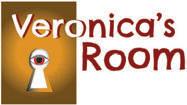


higher pickup rate has not destroyed the family vibe here. People still come and sit and talk and eat,” George Markopoulous said.
In July, the multi-racial, multi-generational crowd that assembled on Nick’s birthday celebration shifted and shimmied around each other. The waitstaff snaked through the tight dining area, balancing




plates and coffee cups through the gaggle of breakfast banter.
The event was symbolic of the standard of service Nick created: People first.
“I’ve been coming here for 40 years,” said longtime patron Gerry Gleason. “I’ve eaten over 12,000 eggs, but I come for the friendship.”











Join visionary, multi-hyphenate, and Grammy®nominated artist Tobe Nwigwe as he performs a onenight-only concert with the NSO. Experience the release of his highly anticipated album, Hood Hymns, as well as a masterful curation of fan favorites.
Steven Reineke , conductor
September 18 | Concert Hall
SEASON OPENING GALA CONCERT Yunchan Lim plays Rachmaninoff’s Piano Concerto No. 2
Noseda conducts Ravel, Bonis & Carlos Simon
Prepare yourself for a night of glamor and romance as classical music’s newest rock star Yunchan Lim performs one of the world’s greatest masterpieces, Rachmaninoff’s sweeping Piano Concerto No. 2. Experience Lim’s electrifying NSO debut at this dynamic concert that also features Ravel’s lyrical La Valse and Carlos Simon’s celebratory Four Black American Dances
Gianandrea Noseda , conductor Yunchan Lim , piano
September 28 | Concert Hall
Noseda conducts Beethoven’s Fifth
You know the famous four-note opening—now, be there for the full glory that is Beethoven’s Fifth Symphony. Imaginative, violent, and wide-ranging, this colossal crowd-pleaser thrusts the audience into Beethoven’s state of mind with roaring tension building to a triumphant, booming climax. Noseda opens the program with Strauss’ Four Last Songs featuring internationally acclaimed American soprano Rachel Willis-Sørensen along with Carlos Simon’s Four Black American Dances
Gianandrea Noseda , conductor Rachel Willis-Sørensen, soprano
October 3–5 | Concert Hall
The Morris and Gwendolyn Cafritz Foundation
Strauss’ Capriccio with Renée Fleming
Noseda conducts Brahms’ First
Acclaimed soprano and Kennedy Center Artistic Advisor at Large Renée Fleming joins the NSO to perform selections from Capriccio, Richard Strauss’ operatic masterpiece about love and artistic discovery. NSO Music Director Gianandrea Noseda closes the program with Brahms’ radiant Symphony No. 1—a noble, tender, towering masterwork of emotion.
Gianandrea Noseda , conductor Renée Fleming , soprano
October 17–19 | Concert Hall
Superstars share the stage at an unforgettable double bill of indie-folk Americana. Grammy®-winning singersongwriter Aoife O’Donovan, deemed “a vocalist of unerring instinct” by the New York Times, explores a century of women’s rights on her latest album All My Friends. Comprised of Anaïs Mitchell (Hadestown), Eric D. Johnson (Fruit Bats, The Shins), and Josh Kaufman (The National, Hiss Golden Messenger), folk band Bonny Light Horseman performs music from its acclaimed new album Keep Me on Your Mind/See You Free—an “ode to the blessed mess of our humanity.”
Steven Reineke , conductor
October 22 | Concert Hall
Indie icon and NSO Artistic Advisor Ben Folds performs hits and new music for his new live orchestral concert album. Widely regarded as one of the major music influences of our generation, Folds’ enormous body of genre-bending sound includes pop anthems with Ben Folds Five, multiple solo albums, and numerous collaborative records. His latest album, 2023’s What Matters Most, is a blend of piano-driven pop-rock songs, while his 2015 Concerto for Piano and Orchestra soared to #1 on both the Billboard classical and classical crossover charts.
Steven Reineke , conductor
October 25 & 26 | Concert Hall









Cars are nothing more than machines, right? You fuel them, maintain them and occasionally wash them, and that’s usually that.
They are not babies. They are not pets. They don’t really have personalities.
They occupy the same category as clothes dryers and dishwashers. They spin, they whir and they do the job they’re supposed to do, without emotion or elan.

But in our family, Flipper was different. He was our 13year-old Chevrolet — a sedan so undistinguished that no one ever tried to steal him or challenge him to a drag race at a red light.
By Bob Levey
He was dowdy, dumpy and drab. He was always threatening to break, go on strike or both. But he got the job done.
Why the Flipper nickname? Because some genius at General Motors had attached a dorsal fin to Flipper’s roof. The fin contained the radio antenna.
Yet this was surely a joke nevertheless. Flipper never reached speeds where his aerodynamics changed. He couldn’t have.
He was a burble-around-town car. He had no similarity to the grace or agility of a dolphin.
He did not have that now-ubiquitous digital screen in the center of his dashboard. He did not have that beeper that warns you not to change lanes. Bless his aging heart, Flipper could still play CDs!
To start Flipper, you turned a key, and the engine came to life with a classic, deep roar. To engage the emergency brake, you stomped down with your left foot — and released that brake with another stomp.
How totally yesterday. Yet, how totally a part of our household.
Flipper was our third consecutive Chevrolet Malibu. We bought the first after we Googled “Car Least Likely to Be Stolen in U.S.” Malibu leapt to the top of the screen.
So Flipper’s grandfather was born to be ordinary. He filled the bill. Never stolen. Never won the Indianapolis 500. Just…a car with a fin.
We gave that car to our son, and bought Flipper’s Daddy, another Malibu. He was just as unfascinating, but so what? He/it worked.
Then, after less than a year, that car drowned in a flood in an underground garage. I took the insurance money and

stayed true to the brand. Flipper soon graced our parking space.
Thirteen years later, Flipper was replaced by Fiddler, a brand-new Kia Niro. Although the spelling wasn’t quite right, the Niro reminded us of Emperor Nero, who fiddled while Rome burned.
Fiddler is not a car. He’s a computer sitting on four tires.
To start him, you push a button. No more key. No more engine roar.
If you drift to your left by even a few inches, Fiddler will beep reproachfully at you.
If you want to engage or disengage the emergency brake, you do that with one finger.
There are two coat hooks in the back (up from none in Flipper).
There are grab bars for all passengers (up from none in Flipper).
There is an amazing platform under the main dashboard that will charge your cell phone without a wire. Just plop the phone there. Fiddler’s electronics do the rest.
As for the screen in the center of the dashboard, it will direct you, phone for you
and find the closest Italian restaurant. Might even shine your shoes while it’s at it.
My wife and I are very pleased with Fiddler. We expect her to be part of the family for a long time. And yet…
Fiddler’s very perfection is somehow annoying. I pine for Flipper’s clunky cruise control. I miss the huge stain on the driver’s seat that we couldn’t get out, despite years of trying.
I actually got used to the lever that raised and lowered Flipper’s driver’s seat. It worked only about one-tenth of the time. But cars outlive their eras. Flipper outlived his. He has been sold to a 17-year-old who needs to get to and from school. Happy trails.
In the meantime, this old guy struggles with his new “child.” Managing the radio is a trip down a space-age rabbit hole. Adjusting the A/C is a major mystery.
Memo to Flipper: For an old bunch of bolts, you weren’t half bad, kid. You may have been boring, but at least you were comprehensible.
Bob Levey is a national award-winning columnist.

From page 1
established Calleva as a licensed nonprofit educational organization.
“Our friends, family, neighbors, and faith community really turned out those first few years to enjoy a few October scares and support our summer camp dreams,” Matt Markoff recalled.
Sept. 25
“We could not have made it through those first five years without a steady stream of creative volunteers and passionate outdoorsmen and outdoorswomen,” he said.
Inspired by uncle
One such outdoorsman was Tom McEwan, the Markoffs’ uncle. He’s known in the whitewater kayaking community for his
Visit the Hefner Auditorium at Asbury Methodist Village in Gaithersburg, MD, and become part of the creative process by providing feedback on “Love and Tear Gas,” a new comedy by the Emmy Awardwinning writer Ken Levine. The reading and talkback afterwards take place on Wed., Sept. 25 beginning at 7:30 p.m. at 201 Russell Ave. The entrance is at the corner of Odendhal and Lost Knife Rds. Admission is free; no registration is necessary. For more information, contact Patty Malatt at PMalatt@asbury.org or (301) 987-6408.
Sept. 28
The 2024 F. Scott Fitzgerald Literary Festival takes place on Sat., Sept. 28 from 8:30 a.m. to 4 p.m. at the Montgomery College Theater Arts Building, 51 Mannakee St., Rockville, MD. The theme is “Writing the Hard Stories.” This year’s festival features authors Jesmyn Ward and Kiese Laymon in conversation, as well as a keynote talk by David Ignatius on “The Impossibility of Trying to Write a ‘Gatsbyesque’ Novel and Other Lessons from a Journo-Literary Career.” Registration is required. The cost is $35 ($30 for seniors). For the full schedule of events and to register, visit fitzgeraldfestival.com. For more information, email fscottfestival@gmail.com or call (240) 389-2636.














first descent of Great Falls in 1975 and his 1998 National Geographic expedition to Tibet.
“We all joke that Uncle Tom was born in the wrong century and should have been on the Lewis & Clark expedition,” Matt Markoff said.
“He was always on an adventure or had one planned. As kids we were awestruck from his stories. We have all shared some sort of kayaking adventure with ‘Tio,’ whether it was in Canada, Mexico or in our back yard.”
McEwan still lives in Maryland and has taught at Calleva’s River School. “He continues to this day to embody adventure, and we try to draw on that same inspiration for our own campers,” said Alex Markoff, director of Calleva Farm.
Thirty-two summers have come and gone, and thousands of kids have passed through Calleva, gaining outdoor skills and confidence.
It’s hard to overstate the camp’s impact. Two counselors who met at camp, for instance, got married at Calleva Farm three years ago. Former campers and counselors keep in touch — and keep coming back year after year.
“Our alumni live all over the country, but they seem to find each other wherever they go,” said Matt Markoff. “We’ve got a whole enclave of Calleva alumni in the









Denver area, a few in NYC, and a whole slew living out in Idaho.
“We are so proud of the community that’s grown up around our mission. It’s absolutely the best part of this work.”
One camper, Shon Kaganovich of Potomac, Maryland, attended Calleva for 10 years and worked as a counselor for two more.
“Calleva was part of the family that raised me. I spent all my summers there, and that was a big part of my upbringing,” Kaganovich said.
“The question wasn’t, ‘Do you want to go to Calleva?’ It was, ‘How many weeks in a row do you want to go?’”
During his dozen years at Calleva, Kaganovich got to know the Markoffs well and noticed their willingness to roll up their sleeves and do whatever was necessary to help. Matt drives the bus, Nick fills in as a ghoul at the haunt, and Alex pinchhits as a counselor.
One summer, when one of the camp leaders was absent, he remembered, Alex “just stepped in and pitched in instead of canceling” the outing, Kaganovich said.
The Markoffs’ dedication could be part of the secret recipe that keeps people like Kaganovich returning for generations.
“We see some of our first campers that became staff and directors travel back to the D.C. area so that their kids can partici-
CAMP , page 43


















pate in the camps that they remember so fondly,” Alex said.
Expanding its footprint
Over its 32 summers, Calleva has expanded its reach. It has two locations in Maryland — at Riley’s Lock on the C&O Canal and at a farm in Darnestown, which has a year-round equestrian program.
Five years ago, Calleva opened a Virginia campus on the Potomac River on the Madeira School’s 250-acre grounds in Great Falls. Its West Virginia program offers rugged, multi-day overnight expeditions at its location on the South Branch River in Romney.
Calleva’s empire of outdoor education also extends to an island in the Potomac River — dubbed Adventure Island — where day campers can canoe out to play in its creeks, make survival shelters and fish.
“Camp has been the foundation of everything that we do, but Calleva has sort of grown up organically over the years as we have expanded our capacity and skill sets,” Matt Markoff said.
Now, he said, the nonprofit offers programs for “adventurers of all ages. All people — regardless of age, experience, or risk-taking capacity — can jump into Calleva and try something new.”
Adults can take evening or weekend
kayaking lessons at the Calleva River School, no experience required. Families can visit the farm for Friday Pizza Nights, where adults can eat while their kids ride on the zip line.
For a fancier touch, there’s a farm-to-table dinner called Tastes of Calleva, a moveable feast made from local ingredients at their farm. Six unique tasting stations are set up throughout the farm, Alex explained.
“Guests roam the farm at their own pace, meet Calleva staff, participate in fun Calleva activities (zip line, pony rides, archery and more), and enjoy a series of delicious small plate dishes.”
With a working sustainable farm and apiary, Calleva also sells its honey, farm yields and baked goods at the Calleva Farm Store in downtown Poolesville.
At all four of Calleva’s hubs, you’ll see busy counselors, happy campers and maybe a Markoff brother or two, carrying on their family’s tradition of embracing the great outdoors.
“Taking inspiration from our family’s love of nature and spirit of adventure, we dreamed up a new way to do camp,” Matt Markoff said.
What’s next? “Well, of course, more adventures,” he said. “More positive experiences, more friendships, more failures, more successes, more ticks, more campfires, more singing — and less screen time!”
Markoff’s Haunted Forest opens on Sept. 27 and runs through early November. For more information, visit calleva.org.

Friends of the Beatley Central Library will hold their Fall Book Sale from Tue., Sept. 18 to Mon., Sept. 22 at the Charles E. Beatley Central Library, 5005 Duke St., Alexandria, VA. Members get early access Mon., Sept. 17. Memberships are $15 and available at the door. Get hardbacks, paperbacks, children’s books, CDs and DVDs, most $4 or less. For hours and more information, visit beatleyfriends.org or call (703) 746-1702.
Are you a 55+ LGBTQ+ person who lives in Montgomery County, MD? If so, StoryCorps would like to interview you in an effort to preserve the stories of LGBTQ+ elders in Montgomery County. Each interview will be archived at the American Folklife Center at the Library of Congress. For more information or to schedule an interview, contact Amena Johnson at amena.johnson@montgomerycountymd.gov or (240) 462-1319.





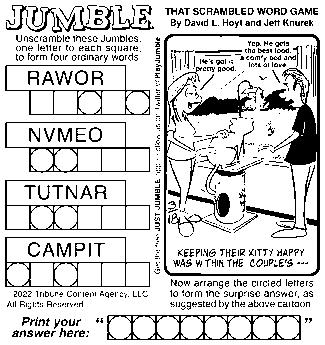
Across
1. Made a choice
6. Enters an amount into eBay
10. Treasure Ricky Henderson stole over 1400 times
14. Mona Lisa got a new one in 1970
15. Vowels that mean Artificial Intelligence Engine Optimization
16. Get Down ___ (top 10 hit for Kool & the Gang)
17. Unsafe for humans
18. Squabble
19. “Save it ___ rainy day”
20. Like a mega-bank, to some
23. Toward the departed port
26. Studio that made 1933’s King Kong
27. Go courting
28. Swamped with incoming calls
35. Quidditch equipment
36. “___ not to reason why...” (Tennyson)
37. Main character in a second person story
38. Shrieking sounds
39. Boiling over with rage
41. Preparing for sleep
42. Supervising cop, briefly
43. Most BMW’s tires should get 32
44. The last entry in allaboutbirds.org’s alphabetical list of common birds
45. Ripe for skepticism
49. “It doesn’t have to be ___ or none”
50. Fellow or buddy
51. Pedicure place
52. Old and ornery
58. More than suggest
59. Singer Amos
60. Nickname of Piedras Negras who invented a popular Tex-Mex snack in 1943
64. First character to appear on The Simpsons opening credits
65. Times listed on JFK monitors
66. Bitter
67. Downwind
68. It is often at the top of a “How I spent My Summer Vacation” essay
69. Heard, for word
Down
1. Frequently, sometimes
2. Golf shop employee
3. Pay voucher deduction
4. Radiate
5. Respectable behavior
6. Youngest person in the dugout, generally
7. It can be read as “four eyes”
8. What you learn after your ABC’s
9. Cyber instructions
10. Rave reviews
11. Small cattle
12. Popular digital assistant
13. List shortener
21. Green-lights
22. Ends to ball- and bass-
23. Under optimal assumptions
24. Choose to abstain
25. Grew fond of
29. Celtics or Bruins, in box scores
30. Part of IHOP’s Quick 2-Egg Breakfast
31. No longer fashionable
32. Popular grills
33. Score the tying goal
34. Water between Asia and Africa
39. Removes from the general population
40. “The best way to get ___ of kitchen odors is to eat out” (Phyllis Diller)
41. Middle school elective
43. It is horizontal in limbo, but vertical in dance class
44. On-line presentation
46. Reproductive cell
47. Member of the woodwind section
48. Future flower
52. Marching band instrument
53. Face-to-face exam
54. Fairy tale villain
55. Go out on a high ___
56. Golf hazard
57. Per person
61. Watch a tear-jerker
62. That guy
63. Praiseful poem
From page 4
By filling the labor demand with legal workers, the incentive for illegal immigration will decrease.
This arrangement offers a sustainable solution to illegal immigration, reducing costs and boosting the economy.
Jasbir Singh (Veteran) Potomac, MD
Ed. Note: You might find it interesting that a report from the Institute on Taxation and Economic Policy found that undocumented migrants paid more than $96 billion in federal, state and local taxes in 2022, with Maryland garnering more than $770 million of that tax revenue.
With some undocumented workers being paid under the table, the study found if migrants had access to legal status such as a guest worker program, as you suggest, the states and localities would realize an additional $7 billion in tax revenue annually, while adding another $33 billion in federal revenue.
By the way, the report showed more than a third of the total paid by undocumented workers goes toward payroll taxes such as Medicare, Social Security and unemployment insurance — programs the same workers are unable to access.
As these people most often rent, they also pay more than $10 billion in property taxes either directly or indirectly via payments to landlords.
Rick Detorie



BUYING VINYL RECORDS from 1950 to 1990 JAZZ, ROCK, BLUES, R&B, DISCO, SOUL, REGGAE, GOSPEL, ANY VINYL FORMAT 33 1/3 RPM Albums, small 45 RPM’s some 78 RPM, Also CD’s, Prefer LARGER COLLECTIONS AT LEAST 100 items, PLEASE CALL JOHN 301-596-6201.
BUYING QUALITY ANTIQUES and midcentury items, including furniture, art, statues, lamps, old signs, military items, gold, silver, costume jewelry, collectibles, toys, tools, anything unusual, etc. Please call Chris at (301) 262-1299. MD licensed.
PAYING TOP CASH FOR ANTIQUES and collectibles. Housecalls made with prompt, courteous service seven days a week and 25 years of experience! Buying toys, trains, militaria, glassware, advertising merchandise, paper items and much more! Contact Mason or Megan at: 443-306-8816.
I BUY GUNS: Military/Civilian Rifles, Shotguns, Pistols MILITARY MEMORABILIA from all wars. am a licensed Firearms Dealer and can legally purchase from you. Call Tim Frank 301-201-0241. historian1975@gmail.com. www.midatlanticmilitaryantiques.com
ESTATE LIQUIDATING? MOVING?cash paid for gold, silver, jewelry, old coins, watches, guns, knives, old comic books, toys old baseball cards, sports memorabilia, christmas, halloween decorations, books, records, etc. Call Tom 240-476-3441.
WILL BUY MILITARY, WWII, WWI, Civil War memorabilia items. Uniforms, weapons, helmets, photos, war souvenirs, medals, photos or any other items associated with U.S., German, Japanese or other military history. Call Dave (240-464-0958) or email (david.obal63@gmail.com).
If you enjoy meeting people of all ages and backgrounds, you may enjoy volunteering with National Mall Visitor Services. Volunteers offer directions around the park, supply maps and brochures, and provide information about the Mall. Training is provided; a background check is required. Shifts are four hours each, from 9 a.m. to 1 p.m. and from 1 to 5 p.m. Volunteers choose their shifts and manage their own schedules. For more information, contact New Thanyachareon at new-thanyachareon@nps.gov or (202) 426-6841. For more information and to apply, visit bit.ly/NationalMallVolunteer.
Pass on your knowledge to a new generation. The nonprofit organization Service Corps of Retired Executives (SCORE), celebrating its 40th anniversary this year, is looking for mentors. You do not have to be retired to become a mentor. Meetings can take place remotely. To volunteer, visit score.org/volunteer/become-mentor or call 1-800-634-0245.
Empowering the Ages is looking for volunteers ages 50+ in Montgomery County, MD, to facilitate school readiness by building a relationship with a local 4-year-old and their guardian for 18 to 20 months. Volunteer 1-2 hours per week online or in person; location and times are flexible. Training, materials and support are provided, including weekly group check-ins. Spanish-speaking volunteers are especially needed. Email volunteer@empoweringtheages.org or call (240) 292-9048.
The Beacon prints classified advertising under the follow ing headings: Business Employment Opportunities; Caregivers; Computer Services; Entertainment; For Sale; For Sale/Rent: Real Estate; Free; Health; Home/ Handyman Services; Miscellaneous; Obituaries; Personals; Person al Services; Vacation Opportunities; and Wanted. For sub mission guidelines and deadlines, see the box on page 47.
CAVEAT EMPTOR!
The Beacon does not know ingly accept ob scene, of fensive, harmful, or fraudulent advertising. How ev er, we do not in vestigate any advertisers or their prod ucts and cannot accept responsibility for the integrity of either. Respondents to classified advertising should always use caution and their best judgment.
EMPLOYMENT & REAL ESTATE ADS:
We will not knowingly or intentionally accept advertising in violation of federal, state, and local laws prohib iting discrim ination based on race, color, national origin, sex, familial status or handicap in connection with employment or the sale or rental of real estate.
3 POSITIONS AVAILABLE No Experience; Training Provided; Great For Seniors and All Others; WFH; PT/FT; No Selling; $2,125/wk/ptnl; EOE; Real Estate; No RE-License Req; Start Immediately; Paid Daily; Call: 1-703-398-1586.
SPRINKLER FOREMAN - VSC Fire and Security in Baltimore, Maryland area. What you need: 2-3 years of experience in installation of fire sprinkler systems, pipefitting, or fire protection codes and standards. Competent in reading plans, documents, and to discern colors for safety signage. Visit vscfire.com/join-our-team/ to apply!
A CARE AGENCY - Been in business for more than 10 years. Experienced nurses, CNAs, GNAs. Any hours you need. Flat rate for live-in. Duties include cooking, housekeeping, bathing, errands, etc. Tel: 667-231-8235.
MOBILE HAIR & NAIL SERVICES - WE COME TO YOU. Professional Licensed Hair Stylist. Women and Men’s Services All Hair Types. Cuts, Styles, Roller Sets, Color, Perms, Men’s Cuts Facial Grooming, Manicures more. Call 301-338-8251.
ARE YOU LOOKING FOR A RELIABLE CAREGIVER? Check out this Agency with high ratings for its cultural sensitivity, excellent customer service responsive and attentive to the needs of clients. Call us 24/7 at 301-364-6699 for information.
A HOME HEALTHCARE - Experienced nurses, CNA, GNA are available 24/7. Cooking, companionship, personal care, housekeeping, driving. Full/Part-time or live-in care. 15 years’ experience. 240-533-6599.
MOBILE HAIR & NAIL SERVICES - WE COME TO YOU. Professional Licensed Hair Stylist. Women and Men’s Services All Hair Types. Cuts, Styles, Roller Sets, Color, Perms, Men’s Cuts Facial Grooming, Manicures more. Call 301-338-8251.
I AM AN OVER-50-YEAR-OLD LADY offering senior care services including light housekeeping, cooking, rides to appointments, companion services, and compassionate and reliable care. Good references. Fairfax and Prince William County only please. Please give me a call at (703)718-1958.
A COMPASSIONATE HOME CARE COMPANION - Providing loving, trustworthy, devoted care for your loved one. Available now for part time position in Montgomery County, Maryland only. HOSPICE trained, 20+ years experience, A+ references. Please call SADIE (240) 522-9591, leave voice message for reply.
RETIRED AND ACTIVE MEDIA EXECU-
TIVE, now interviewing: For friendly person with pleasing personality for potential position as live in personal companion. Accommodation and meals provided with private bedroom, bath and parking! Location near American University in DC. Ideal opportunity possibly for Grad Student (or other qualified person) to have daytime access to nearby Universities: American, Georgetown, and GW for early daytime classes. Companionship position duties include: light meal and housekeeping activities and shopping at near by pharmacy and restaurants. Schedule to be days with Tuesdays and Fridays free. Compensation based on mutual agreeable arrangements. Please respond by email to James, jconnelly127@ gmail.com
#1 CHOICE IN HOME AND HEALTH CARE. We provide long term live-in or live-out CNA’s, caregivers, housekeepers, companions, personal assistants, drivers, personal trainers or any other employee needed to provide the needs of a senior adult at their home. For more information and to place an order call 240-432-8560.
PROBLEM WITH YOUR PC/MAC OR NETWORK? Computer Systems Engineer will come to you with help. Call David G. at: 301-3282112 301-642-4526.
TAX PREPARATION. Licensed CPA 35+ years, reasonable rates; will travel within 20 miles. Located in Gaithersburg near Rte 270/370. DIANE CHRISTEN CPA; dianechristen@aol.com; 240-355-1135 cell.
UP TO $15,000.00 OF GUARANTEED
LIFE INSURANCE! No medical exam or health questions. Cash to help pay funeral and other final expenses. Call Physicians Life Insurance Company 866-212-1092 or visit www.Life55plus.info/beacon
WESLEY FINANCIAL GROUP, LLC
Timeshare Cancellation Experts. Over $50,000,000 in timeshare debt and fees cancelled in 2019. Get free informational package and learn how to get rid of your timeshare! Free consultations. Over 450 positive reviews. Call 855-626-8703.
FOR SALE NATIONAL MEMORIAL PARK, choice sites in desirable Block A, a $14,000 value. Includes Vaults and Markers an additional $6,000 value. Total package of $20,000 discounted to $7,400 or OBO. Call Joe 703-969-5111.
PREPARE FOR POWER OUTAGES TODAY with a Generac Home Standby Generator. Act now to receive a FREE 5-Year warranty with qualifying purchase. Call 1-301-960-3174 today to schedule a free quote. It?s not just a generator. It?s a power move.
NEW WINDOWS FROM WINDOW NATION. Special money saving offer zero down, zero payments, zero interest for TWO years AND buy windows and get FREE! Offer is valid for select models. Labor not included. Other restrictions apply. Call Window Nation today! 855-909-2278.
PROPERTY MANAGEMENT - “GET THE BOOK” - Contact us at McConkeyTeam@Aol.Com or 202-255-1900 and we will provide you with a customized binder containing a) the latest price information on similar neighboring properties, b) what we would do specifically to get you the best price in the shortest amount of time, and c) all the necessary legal forms to get started to rent and/or manage your property. “NO cost, NO obligation” Sell DC Real Estate.
PORTABLE OXYGEN CONCENTRATOR
May Be Covered by Medicare! Reclaim independence and mobility with the compact design and long-lasting battery of Inogen One. Free information kit! Call 855-851-0949.
WELCOME TO REDZONE FITNESS STUDIO. We can come to you to get you in the best shape of your life. We offer personal training and assisted stretching. We also have fantastic private studios located in Gaithersburg, MD and Chester, MD so far. Call Anthony at 410-7393318 to set up a free fitness evaluation. We are always looking for great talent. If you are a personal trainer, massage therapist or physical therapist call Anthony at 410-739-3318 to set up an interview. We look forward to meeting you.
DENTAL INSURANCE from Physicians Mutual Insurance Company. Coverage for 400 plus procedures. Real dental insurance NOT just a discount plan. Do not wait! Call now! Get your FREE Dental Information Kit with all the details! 1-844366-1003 www.dental50plus.com/320 #6258
MOBILEHELP, America’s Premier Mobile Medical Alert System. Whether You’re Home or Away. For Safety and Peace of Mind. No Long Term Contracts! Free Brochure! Call Today! 1240-650-9189.
STROKE AND CARDIOVASCULAR DISEASE are leading causes of death, according to the American Heart Association. Screenings can provide peace of mind or early detection! Contact Life Line Screening to schedule your screening. Special offer screenings for just $149. Call 1-844-485-7035.
NORTH VA ELECTRICAL SERVICES. We
Install: Ceiling Fans, Recessed Lights, Chandeliers, Power outlets Other related work. We are Licensed Insured. Feel free to call or text to: (703) 898 0797.
SLOWING DOWN AFTER 42 YEARS of contracting. Small to medium jobs mainly residential but will do some commercial work. Will work all over DC area. $45 dollars from arrival on job. Andy 703-906-5429.
MOVING OR LIQUIDATING AN ESTATE?
Let Downsizing Specialists, LLC show you how our easy process helps you decide what to keep, gift, sell, donate, or discard. Services include estate liquidation, downsizing, estate sales, house and storage unit clean-outs, and junk removal. We buy estates, vehicles, real estate. Free estimates. Local. Family Owned. Licensed. Insured. Downsizing doesn’t erase history, it shapes the legacy left behind. Call/Text Philip 301-2193600 DownsizingSpecialists.com
STORAGE SHEDS BUIT ON SITE. Licensed and insured. No permits required. Starting at $3,000. www.Townandcountrysheds.com. Call Noah 571-214-0511.
THE BATHROOM OF YOUR DREAMS in as little as day. Limited Time Offer $1000 off or No Payments and No Interest for 18 months for customers who qualify. BCI Bath Shower. Many options available. Quality materials professional installation. Senior Military Discounts Available. Call Today! 1-855-653-0087.
DON’T LET THE STAIRS LIMIT YOUR MOBILITY! Discover the ideal solution for anyone who struggles on the stairs, is concerned about a fall or wants to regain access to their entire home. Call AmeriGlide today! 1-866-365-5170.
SAFE STEP. North America’s #1 Walk-In Tub. Comprehensive lifetime warranty. Top-of-theline installation and service. Now featuring our FREE shower package and $1600 Off for a limited time! Call today! Financing available. Call Safe Step 1-866-478-2363.
AMERICAN RESIDENTIAL HEATING & COOLING. As temps outside start to climb, the season for savings is now. $49 cooling or heating system tune up. Save up to $2000 on a new heating and cooling system (restrictions apply.) FREE estimates. Many payment options available. Licensed and insured professionals. Call today 1-877-691-0273.
ELIMINATE GUTTER CLEANING FOREVER! LeafFilter, the most advanced debrisblocking gutter protection. Schedule a FREE LeafFilter estimate today. 20% off Entire Purchase. Plus 10% Senior Military Discounts. Call 1-855-977-6078.
CONSUMER CELLULAR - the same reliable, nationwide coverage as the largest carriers. No long-term contract, no hidden fees and activation is free. All plans feature unlimited talk and text, starting at just $20/month. For more information, call 1-833-742-1303.
BECOME A PUBLISHED AUTHOR. We want to Read Your Book! Dorrance PublishingTrusted by Authors Since 1920. Book manuscript submissions currently being reviewed. Comprehensive Services: Consultation, Production, Promotion and Distribution. Call for Your Free Author`s Guide 1-833-992-0110 or visit dorranceinfo.com/beacon
INTERIOR DECORATOR: Will do interior decorating in your home/business. Free estimate. (281) 773-1770. Laurel area. EVERY TIME YOU WALK OUTSIDE a layer of microbes lands on your skin. They cause aging. Rose Beauty Cream takes them away. Sharon, a Leisure World resident says, “I won’t be without my Rose Beauty Cream,” www.barbarafrank222.com or call 301-949-4873.
GET DISH SATELLITE TV + INTERNET! Free Install, Free HD-DVR Upgrade, 80,000 OnDemand Movies, Plus Limited Time Up To $600 In Gift Cards. Call Today! 1-844-560-5837.
DIRECTV - All your entertainment. Nothing on your roof! Sign up for Directv and get your first three months of Max, Paramount+, Showtime, Starz, MGM+ and Cinemax included. Choice package $84.99/mo. Some restrictions apply. Call DIRECTV 1-888-572-4953.
I PERSONALLY COLLECT AND WANT TO BUY old Christmas and Halloween decorations, Herend and Royal Copenhagen porcelain, costume and fine jewelry and other pretty things. also buy out estates, full or partial. Or, can send items to auction for you. Please call Susan, (301) 785-1129. Maryland license #2753. ALWAYS BUING OLD COSTUME JEWELRY, sterling silver flatware hollowware, school rings, gemstones broken jewelry, old comic books(pre-1980) old baseball cards (pre1975), and other old items you have. Text or call Alex at 571-426-5363 DMV Area.
CASH FOR ESTATES; buy a wide range of items; art, antiques, jewelry, cultural items, furniture, collections/accumulations. Whole estate/single item. Visit theatticllc.com or call Gary: 301-520-0755. License #18-SH-004-233.
CASH FOR JEWELRY: Buying jewelry, diamonds, gold, platinum, silver, watches, coins, flatware, etc. Ask for Tom. Call anytime, 301654-8678 (Reg. 883).
WANTED: OLDER VIOLINS, GUITARS, BANJOS, MANDOLINS, UKULELES. Musician/collector will pay cash for older string instruments. Jack (301) 279-2158, leave message phone number (please speak slowly).
CASH FOR RECORDS, CDS AND DVDS. Best price guaranteed. Free appraisals. All types of music {33, 45, 78 CDs.} Also buying turntables and stereo equipment. Will make house calls with CURBSIDE PICKUPS. Call or text Steve at 301-646-5403.
REDISCOVER YOUR VITALITY! Specializing in women’s health with acupuncture services. We offer appointments in your home and in our convenient Rockville and Gaithersburg offices. Call (410) 733-8380 or email holistichealthbeautymd@gmail.com
JACUZZI BATH REMODEL can install a new, custom bath or shower in as little as one day. For a limited time, waiving ALL installation costs! (Additional terms apply. Subject to change and vary by dealer. (Offer ends 12/29/24.) Call 1833-994-0538.

Answer:
All classified ads must be submitted and paid for online, via our website, www.thebeaconnewspapers.com/classifieds
Deadlines and Payments: To appear in the next issue, your ad text and payment must be entered by the 5th of the preceding month (for Baltimore and Howard County editions); by the 20th (for Washington edition).
Cost will be based on the number of characters and spaces in your ad:
• $25 for 1-250 • $35 for 251-500. • $50 for 501-750 (maximum length). The website will calculate this amount for you.
Note: Maryland contractors must provide a valid MHIC number.
• Each real estate listing qualifies as one ad. • All ads are subject to publisher’s discretion. Payment will be refunded if unacceptable for any reason.
To place your classified ad, visit www.thebeaconnewspapers.com/classifieds










































